
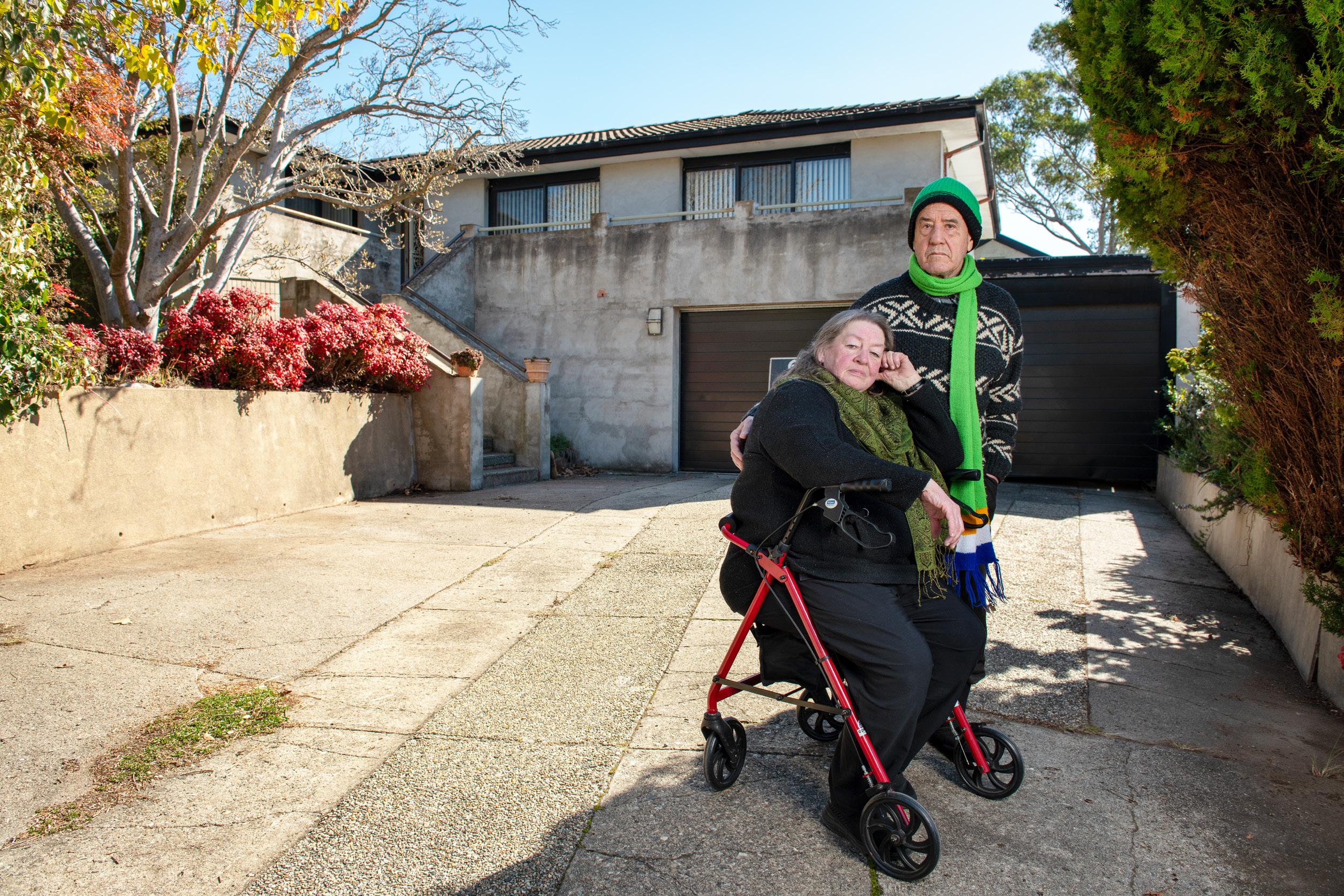


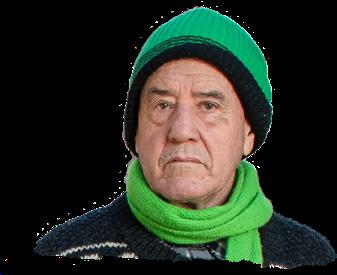
Leo and Lorraine Carvalho are trapped in a home they can’t sell, victims of challenging the ACT government’s Mr Fluffy valuation –a cynical and flawed scheme, say JON STANHOPE & KHALID AHMED







Leo and Lorraine Carvalho are trapped in a home they can’t sell, victims of challenging the ACT government’s Mr Fluffy valuation –a cynical and flawed scheme, say JON STANHOPE & KHALID AHMED

Arthritis, Pain Support & Emerge ACT is pleased to announce that they will be hosting hydrotherapy pool sessions at the new Tuggeranong Aquatic Centre’s Hydrotherapy Pool.
To utilise our hydrotherapy services at this pool, or at Calvary John James or University of Canberra Hospital, please call us directly on 1800 011 041 or Scan the QR Code for more details.
All users must be financial members of our Foundation and pre-purchase session tickets. Arthritis ACT staff are always available at our pool sessions, and we provide a wide range of therapeutic hydrotherapy exercise aids, exclusive to our users.
Additional sessions are also available at Calwell Learn to Swim and Aqua Harmony in Kambah (book directly through those pools). Our staff attend these sessions too, to help you with your hydrotherapy program.

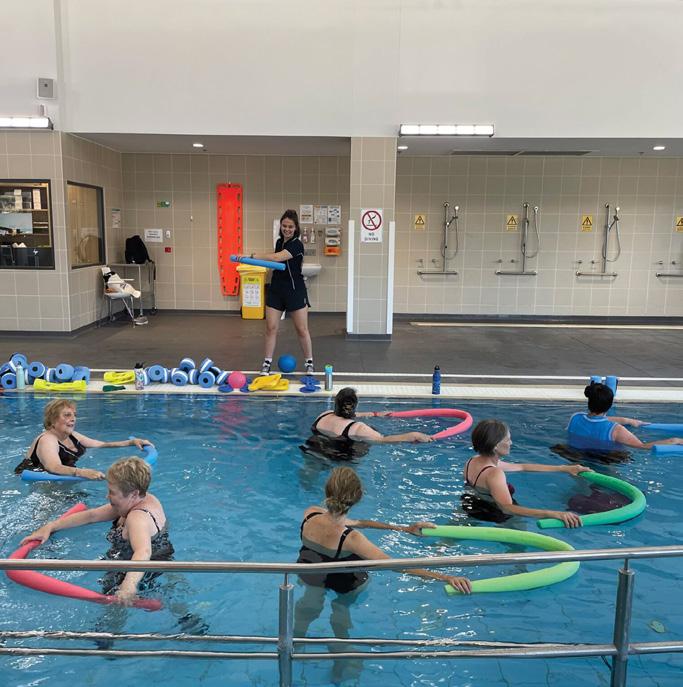
• Tailored Exercise Classes – Strength & Balance, Mat Pilates, Yoga (Chair & Floor), Nordic Walking, and more
• Hydrotherapy Sessions – Gentle, warm-water therapy for pain relief and mobility
• Allied Health Support – Accredited Exercise Physiologists for personalised care
• Pain management programs, lifestyle support, and community wellbeing initiatives
Join our community today – because your best years are still ahead!
Call us now 1800 011 041 or scan the QR code to get started.


By Elizabeth KOVACS
Nineteen-year-old Chelsea Bagnall shouldn’t be alive.
At 14 and only 40 kilograms, she was vomiting and fainting daily.
Chelsea says she was seen by psy chiatrists across Newcastle who, with out conducting tests, assumed she had an eating disorder.
Misdiagnosed with Avoidant Restric tive Food Intake Disorder (ARFID), she was put on a supervised eating plan.
“You had 20 minutes to finish a certain amount of food, if you didn’t finish within the time, they’d take the food away, you didn’t have a choice,” says Chelsea.
“They’d replace what you didn’t eat with a bolus feeding tube (liquid food).”
In extreme pain every time she tried to eat, Chelsea was often unable to finish.
Unknown at the time, Chelsea had gastroparesis, a condition where the stomach doesn’t empty properly, a result of Median Arcuate Ligament Syndrome (MALS), a condition that compresses the celiac artery nerves, making eating excruciatingly painful.

“I was constantly questioning why they didn’t do any tests.
“I know my body, I know something was wrong and I was refused.”
rywhere,” Chelsea says.
For two years, Chelsea moved between gastroenterologists.
came across MALS and Superior Mesenteric Artery Syndrome (SMAS), a condition in which the small intestine is compressed causing nausea,
Admitted to Queanbeyan Hospital in 2024 with seizures, vomiting and more pain, Chelsea was shocked when the doctor listened to her suspicions about her condition and ordered tests.
Queanbeyan Hospital has the only doctor skilled in completing the relevant tests, with patients travelling to
“I didn’t think too much of it because I’ve had many scans come back, but when he came in with a funny look on his face, I thought, ‘Oh my god, you’ve done it, you’ve found something.’ We
The scans revealed that Chelsea’s SMAS was crushing her renal vein, a blood vessel that carries blood from the kidney to the heart. Her MALS
On July 9 at the Calvary Bruce Private Hospital, Chelsea had what she describes as a lifesaving operation to remove the extra nerves around her
She says the surgeon described it as the largest number of nerves he had ever removed.
system is, for nurses and patients alike.
“The nurses have been wonderful and have followed my story the whole time,” she says.
“But I’ve been ignored, pushed to the side and put under scrutiny for being unwell [by doctors].
“It’s a massive relief to think they’ve figured it out, but there’s also a little voice in my head that thinks, ‘if they’ve only just figured this out now, what else have they missed?”
There is no known cure for MALS and SMAS. Due to the severity of her condition, Chelsea will have ongoing issues for the rest of her life, such as inability to stand for long periods of time, resurgences of pain, nerve damage and intestinal mobility issues.
Chelsea missed two years of her education and was not able to graduate year 12.
Now on bedrest at home for an initial six weeks, with a further year of working closely with specialists to understand the long-term impacts of her condition.
For now, future job prospects are on hold as Chelsea learns how to navigate this new reality.
“You know your body, you know if something is wrong,” she says.
“My stomach was holding food from the day, which caused me to vomit and become extremely nauseous, and I was
In four NSW hospitals seven times, sometimes for months at a time, Chelsea’s mental and physical health
“Once you feel failed by the hospital system, you seek answers yourself,” she says.
Chelsea started researching and
Looking forward to eating her grandmother’s “famous cooking” without severe pain, Chelsea says it’s been an eye opener to see how broken the healthcare
“Don’t let someone’s incompetence stop you from advocating for yourself.”
Donations for Chelsea’s recovery at gofundme.com
Arts & Entertainment 23-26
Crossword & Sudoku 27
Dining & Wine 26
Gardening 22
Keeping Up the ACT 11
Letters 12-13
News 3-13
Politics 4

Streaming 25
Cover: Leo and Lorraine Carvalho are trapped in a home they can’t sell. Story Page 8 Photo: Andrew Campbell.
Since 1993: Volume 31, Number: 34
General manager: Tracey Avery, tracey@citynews.com.au
Advertising account executives: Damien Klemke, 0439 139001
Ashika Nambiar, 0425 149860
Editor: Ian Meikle, editor@citynews.com.au
Journalist: Elizabeth Kovacs, elizabeth@citynews.com.au
Arts editor: Helen Musa, helen@citynews.com.au
Production manager: Janet Ewen
Graphic designer: Mona Ismail
Distribution manager: Penny McCarroll





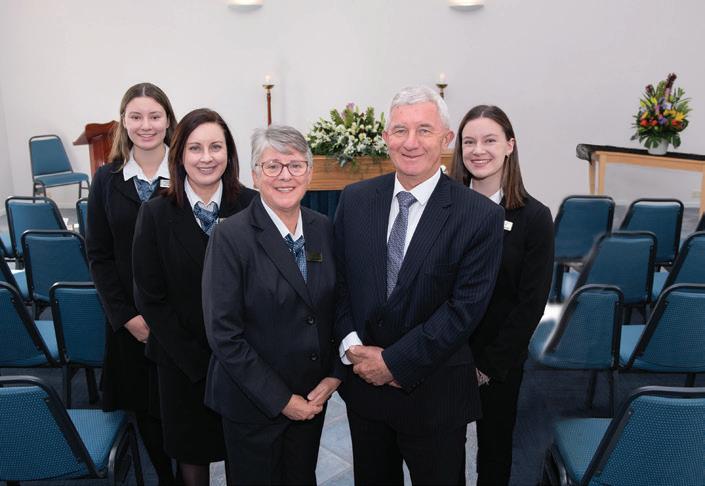

How long does it take to get an appointment with a medical specialist?
The medical colleges that govern how many specialists can be part of the profession have an inherent conflict of interest. In a similar vein, the ACT Law Society has the power to judge and disenfranchise its members.
Professional groups have been at the core of ensuring high-quality services for many years. The calibre of professionals in the law and in medicine are amongst the highest in the world. But is it right the way these organisations protect their own power, jobs and money?
As these professional groups are both part of maintaining standards and are also advocacy groups, they have considerable power and influ ence along with an inherent conflict of interest.

The Royal Australasian College of Physicians, for example, sees its triple role as “educate”, “advocate” and “innovate”.
I have the greatest respect for the work of this college and the range of other specialist medical colleges. However, we simply do not have enough specialists. The inherent conflict of interest is that incomes are well protected when there are not enough specialists.
ance systems.
In 2013 the Australian National Audit Office (ANAO) found inconsistencies in training approaches and concerns about transparency and fairness of the processes.
The Australian Medical Council (AMC) overseas medical training and overseas standards of education, training and assessment of the medical profession. Their role is to “promote and protect the health of the
Australian community”.
However, the long, long waits for specialists, and the out-of-pocket expenses incurred indicates that the AMC’s role in the “protection and promotion of the health of the Australian community” is not working so well.
It is time for all Australian Ministers of Health to break down the collusion that is effectively built into the processes for accrediting our medical specialists.
It is not just the medical colleges that have the conflict of interest. The ACT Law Society is going through torrid times. The society is considering a process of reform. However, the process may well focus even more power in the hands of fewer people.
No wonder it is torrid times! The concept of being both a membershipbased representative organisation, and a regulator makes little sense. This arrangement also creates a conflict of interest.
The Law Society says its role is to “represent, advance, and defend
the interests of an independent legal profession in the ACT”. A sensible enough role for a membership-based organisation.
However, it also claims to “protect the public interest in the ACT system of justice through the efficient regulation of the profession”.
The role also includes “lobbying and consultation to protect members’ interests and to defend the reputation of the legal profession in the ACT”.
The ACT Law Society has significant powers to regulate and oversee lawyers practicing in the ACT. These powers stem from the Legal Profession Act 2006 (ACT) and include setting rules for legal practice, maintaining professional standards, handling complaints about professional conduct, and prosecuting disciplinary matters.
The society also plays a role in protecting client and public monies and providing legal assistance.
Disciplinary actions taken against lawyers may also include prosecuting matters before the ACT Civil and Administrative Tribunal (ACAT).
The society claims to represent the profession, and there is significant power in the hands of the council, and
particularly its executive committee. There are proposals to grab even more power by cutting the size of the council, including non-elected members and increasing the length of terms.
Less than a third of ACT Law Society members have voted for those standing for council. This is hardly the grounds for wholesale changes to an organisation that carries such significant power.
It is a challenge for ACT AttorneyGeneral Tara Cheyne. As changes to the Constitution of the Law Society need to be approved by the attorneygeneral, she should work with her predecessor, the Greens leader Shane Rattenbury, and other Assembly colleagues to examine the possibilities to improve and protect the integrity of the profession.
Michael Moore is a former member of the ACT Legislative Assembly and an independent minister for health. He has been a political columnist with “CityNews” since 2006.















, daughter of the fifth director of Mt Stromlo Observatory, Don Mathewson, is moved to reminisce about her years growing up on ‘the mountain’.
Last year marked the anniversary of the 100th year of Mt Stromlo Observatory. What a milestone! I often revisit the director’s house, known as Observatory House, where we lived for 14 years.
Completed in 1928, it was the residence for the observatory’s directors and their families, as well as a venue for social events. The house is now a museum.
The garden is mostly gone except for the old English oak tree, which we all adored and sheltered under, a witness to the last 100 years. A survivor of bushfires. A constant companion throughout my time as the daughter of the fifth director of Mt Stromlo Observatory.
I was brought to Mt Stromlo Observatory as a six-month-old in September, 1966.
My father, Don Mathewson, accepted a fellowship at Mt Stromlo and Siding Spring observatories (MSSO) of the Australian National University.
Little did he know that this was the beginning of a star-dusted journey spanning 30 years.
It was a journey enriched by all the
talented people of MSSO, politicians and prime ministers, chancellery of the ANU, television and radio networks and international collaboration with NASA and Canada to produce STARLAB, a space telescope project.
Mt Stromlo Observatory gave my father a meteoric rise into a leadership position. Within just over 10 years of arriving on the mountain, he became acting director of MSSO in 1977, rising to director 18 months later in April 1979.

The headlines read “First Australian director for observatories”.
The ANU reporter continued that “he had many firsts to his name”, including the discovery of the Magellanic Stream.
It was an exciting time for Australian astronomy with support from science ministers (including Sir Phillip Lynch and Senator John Button) that enabled greater international collaboration and recognition.
Stromlo also gave us children the perfect playground. Our thoughts and imaginations soared high as we romped around the pine forest with the stunning backdrop of the blue hue of the Brindabella ranges to the west.
Observatory House gave my father
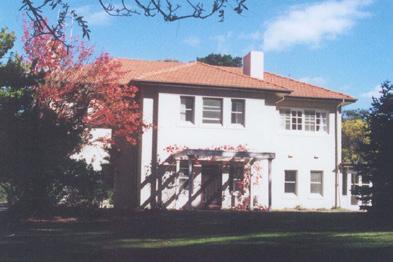
the perfect setting for promoting astronomy and inspiring politicians and business people to invest in “the last frontier”.
I remember numerous meetings, buffets, dinners with NASA and Canadian engineers.
We had only just moved into Observatory House from another house on the mountain, when my father asked the then science minister Phillip Lynch to dinner and a tour around the telescopes to see the latest developments. The next day, a cheque for $3 million was given to support the ongoing Mount Stromlo Observatory projects!
The dining room gave such a vibe of excitement, passion and enthusiasm for the infinite possibilities that the universe tantalises us with.
My father had many long chats in that dining room with Pip Morgan, a top Hawker de Havilland engineer, and as a result of their discussions AUSPACE, the first Australian Space Company was born.
It is written that “Don was largely responsible for taking Australia into the space age”, or in the words of his colleague Prof Michael Dopita, “kicking and screaming into the space age!”
I will never forget when all of parliament came up to Stromlo to observe Halley’s Comet on April 7, 1986. The mountain was alive with federal ministers from all parties bustling around like excited teenagers on a school excursion, as they were about to observe the comet remotely using telescopes at Siding Spring Observatory.
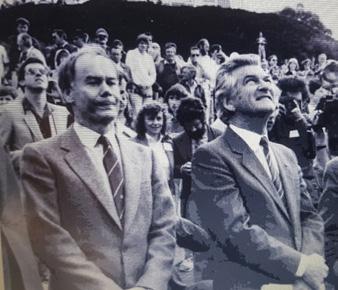
Afterwards my father got into the car to go to the telescopes with Prime Minister Bob Hawke and, to make room for him, Hazel Hawke sat on Bob’s knee.
She drily remarked: “It takes a comet to get me on Bob’s knee!”
As I walk away from the old house, I can hear laughter and the clonkclonk of croquet balls as many walks of life battle it out on the large green croquet lawn in front of the house.
Friends, family, engineers, accountants, university chancellors, ambassadors, heads of CSIRO departments, politicians all united under the stately presence of Observatory House and the watchful eye of the old oak tree.
Don Mathewson (1929-2025) died on June 25. He was 96.


Orthopedic surgeon Dr Sindy Vrancic resigned from Canberra Health Services after an intractable dispute over new working conditions being forced on doctors. Here she reflects on 15 years at the department she loved…
Resigning from Canberra Health Services (CHS) was not something I thought I would ever do.
My plan was to continue to be active in the orthopedics department and to mentor the new team of surgeons we hoped to recruit over the next few years.
That plan has now dissolved and the unit has publicly disintegrated, with three of the department resigning in frustration, and the remaining surgeons evaluating whether they will stay once their current contracts expire over the next two years.
One of my regrets in resigning is leaving behind more than 75 patients on my elective waitlist, and many patients who are yet to be seen in my upper-limb outpatient clinic.
What’s more, as I was the most senior trauma upper-limb surgeon, I wonder what will happen to the existing trainees and fellows now that my teaching capacity has evaporated.
I regularly took on patients from Wagga, Goulburn, Cooma and Bega on direct referral from other orthopedic surgeons unable to offer care based on their location and skill set.
CHS is now actively blocking these referrals, I’m told – wanting CHS to only see ACT patients.
Now those remote surgeons will need to decide where in NSW they will send their uninsured complex shoulder patients.
I am disappointed that my contribution to CHS has been downplayed to being minimal by Health Minister Rachel Stephen-Smith in media interviews.
Since 2009, I have signed five threeyear contracts as a visiting medical officer (VMO) fee-for-service orthopaedic surgeon with ACT Health.
I have been a very active surgeon in the field of training and education.
As one of the five per cent of female orthopedic surgeons in Australia (it was less than three per cent when I started), and one of the few who continued to work in the public system doing general orthopedic trauma, my role was to also be an example to junior female doctors to show that you can be a female surgeon, even in orthopedics.
I championed the room in theatres that met the breastfeeding guidelines for our doctors.

I was instrumental in implementing the ortho roster to meet national safe working hours guidelines, and regularly juggled to ensure all the needs of our trainees and fellows were being met – all of this non-surgical work was done out of hours.
The whole health system has been subjected to massive hurdles, from covid to the Calvary fires to the digital health records.
As if these weren’t enough, then there was the move to the new hospi-
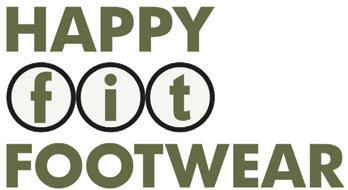
tal building. To experience first-hand the poorly efficient new operating theatres was embarrassing.
The lack of equipment, the lack of space and staff to manage the simplest of actions such as sterilising trays and equipment, and the significant time delays just trying to get a patient to the theatre complex from the ward was taxing. But, we all tried to continue to push for efficiency in the best interest of the patients.
As an active surgeon faced with these challenges, to then be told our contracts wouldn’t be renewed, and that we would only be offered sessional rates or salaried positions… this was one step too far for me. It’s not about the money; it’s about being valued and appreciated for what we do.
I will miss caring for my patients. There has been sadness with poor outcomes, and happiness with good outcomes.
I have cried with families after the death of their loved ones, and I have happily cared for multiple family members over the years. I am grateful for the trust that patients put in me.
What I won’t miss is the continual and ever-increasing interference by executive in my capacity to offer timely care for my patients.
If I assess a patient and believe that they should be offered elective surgery within three months, then that is their category. That is my role as the
surgeon – don’t change the category because the name of the operation doesn’t fit the national guidelines. I treat all patients as individuals.
My resignation was not an easy choice. I am not retiring, despite what has been incorrectly stated in the media. I am at the peak of my surgical expertise, but that skill is now only available to those able to access the private system.
The loss is being felt by those currently in the public system and those waiting to see an upper-limb orthopaedic surgeon to manage their disabilities.
The sharp change in direction at CHS will forever change the orthopedic department, and all other departments who still have VMOs.
Our departmental mix of all VMOs was unique. We were one of the most cohesive and synergistic groups of like-minded surgeons.
But the VMO will soon be an extinct breed, with irreversible loss to the most important people in CHS –the patients.
So, goodbye to my friends and colleagues at CHS, I will miss all of you.
To Rachel Stephen-Smith I offer the words of Joni Mitchell: “Don’t it always seem to go, that you don’t know what you’ve got ‘til it’s gone.”
This is an edited version of the column first published in The Canberra Doctor.



A woman came into my clinic for a consultation about her hearing aids, telling me her hearing aids were 4 years old and she had never found them to be of much help. She said the salesperson quoted her $14,000 for a pair of hearing aids, however, the monthly special of 20% discount meant they cost her $11,200. So, she ‘only’ paid $11,200 for hearing aids that did not help her. Sadly, I hear this all too often.
Here are some things to do to avoid this type of problem:
1. Visit your GP. If you or someone you know has a problem with their hearing, visiting your GP to check for wax in the ears, and to get advice is a starting point.
2. Qualifications. Always check the qualifications of the person you are dealing with. A person without professional qualifications has no business advising you about your hearing. They need to belong to a professional association with a Code of Conduct, so you know they are acting in your best interests, not their own.
years. If you are not sure about their advice, then seek a second opinion. The wrong hearing aids can be an expensive waste and could lead you to stop wearing them. You should always have a trial of hearing aids to ensure that they are right for you.
6 Pensioners and eligible DVA card holders often have entitlement to free services. If you are covered by a government concession, then let the clinician know (even though your clinician should ask). Eligible clients may obtain free hearing tests, consultations, and free hearing aids (referred to as fully subsidized hearing aids).
“A person without professional qualifications has no business advising you about your hearing. They need to belong to a professional association with a Code of Conduct, so you know they are acting in your best interests, not their own.”
– Dr Vass
These hearing aids are appropriate for many people, however if you have great difficulty hearing in background noise (for example a restaurant), then you may want to consider partially subsidized hearing aids. This is when the government pays a certain amount, and you pay for additional features and benefits. Your decision should be based on the following:
you are dealing with a qualified clinician, then they belong to a professional association. The best contact is an independent complaints body referred to as Ethics Review Committee. You can email ethics@auderc.org.au and view the website www.auderc.org.au. You can make an anonymous complaint and your complaint will be handled in a confidential and professional manner. If you are in the ACT, contact the ACT Human Rights Commission email human rights@act.gov au and the website www.hrc.act.gov.au
3. Independent advice. You should get independent, professional advice.
4. There are a wide range of hearing aids out there. Finding the right hearing aids for your communication needs can be challenging. Hearing aids vary in price and performance. Bluetooth® connectivity and rechargeable hearing aids are available on most hearing aids, along with apps that allow you to control your hearing aids from your mobile device. Be aware that just because a hearing aid is more expensive, that doesn’t mean they are the best hearing aid for you.
5. Just as hearing aids vary in performance, clinicians may also vary in performance due to training, experience, and skills. Make sure that you are comfortable and confident in their advice. You are likely to be with this clinician for the life of your new hearing aids, typically 4 to 5
(a) Can you afford the more expensive hearing aids? Don’t go into financial stress if you can’t afford them. (b) Are you clear on the free vs partially subsidized features & benefits? Never believe someone who tells you the free hearings are not good or of poor performance, this is simply not true. (c) If you try the partially subsidized hearing aids and are not happy, then return them. Do not keep hearing aids because you think the failure is yours or that you will improve over time. If the hearing aids are not working for you in the trial period, then they will not work for you in a year or two.
7. If you have a complaint, then seek help. Your clinician should be able to help you through most of your needs. Sometimes, a problem may be beyond the expertise of even the best clinician. However, if you have a complaint there are things you can do. If


‘The Carvalhos bought their Lyons home not knowing that it was what is generally known as a ‘Mr Fluffy’ house’

“As I approach my 81st birthday, living on the streets in Canberra’s cold and damp winter with my wife, who is living on borrowed time, is not exactly appealing for a fiercely independent couple who have taken no handouts from either the federal or ACT governments.”
This is the lament of Leo Carvalho and his wife Lorraine.
They do have a home, and yet they are “homeless”. They are victims of challenging the ACT government’s asbestos eradication program valuation.
The Carvalhos bought their Lyons home not knowing that it was what is generally known as a “Mr Fluffy” house.
The ACT government knew, but at the time did not publicly identify the properties affected by loose fill asbestos. Nor did it require, at that time, that that information be disclosed in contracts for sale.
It is moot whether such information would have made the Carvalhos and many others in a similar situation any more responsible for the circumstances in which they found themselves in 2014.
History of Mr Fluffy and the original removal program
A full description of the decadeslong Mr Fluffy history is not within the scope of this article. However, some key facts are relevant and we have drawn the following from researched and referenced publications.
Loose fill asbestos was marketed as Asbestosfluf and installed in homes in Canberra and surrounding NSW between 1968 and 1979. This material, typically sprayed into the roof cavity, is much more dangerous than the compressed sheets used in buildings, as it is obviously much more likely to become airborne.
Concerns had been raised by a government expert about the health effects of asbestos on installers as well as the general community as early as 1968 with a recommendation that asbestos installation be banned. However, in 1972, the product was rebranded as ‘Amoswool’ and marketed as being both safe and as adding market value to a home.
While the ACT and Commonwealth governments undertook a joint program to remove loose-fill asbestos from 1060 Canberra dwellings between 1989 and 1993, there is clear evidence that it was recognised by relevant officials that the program would not and did not result in the complete removal of loose-fill asbestos in all the houses.
Each affected homeowner received a Completion of Asbestos Removal Work notice that advised that some residual asbestos may be present in their home. This information was placed on all the relevant building files; however, it was not required to be disclosed in contracts for sale of

A local print advertisement for Abestofluf (circa 1968-79)... “It sprays on to ceiling areas quickly and cleanly”.
those dwellings until 2004.
The Carvalhos bought their home in 2003. They spent $600,000, through three DAs, on renovations to the house and received a final certificate of occupancy in 2013.
Government officials and housing industry representatives were of the view that the program initiated in 1989 would not completely remove asbestos, and that a full demolition was the only option for complete remediation. This was confirmed by some private removals of asbestos at that time in houses in which asbestos was detected post its apparent removal.

a pathway could surely have been incorporated in the program under which the demolition and clean-up works were done to established standards by accredited firms.
The 1989-1993 program was, therefore, unsuccessful in some measure in that not only were there cases where not all of the asbestos was removed but there were also some houses that were overlooked altogether.
In 2013 evidence became available that loose asbestos particles had migrated to the wall cavities and structure of a house overlooked or missed in the original removal program. Until then, the “missed” houses in the original program were remediated to that standard.
In light of this, a further program was initiated in 2014 based on a decision that the full demolition and cleanup of an affected house was required in order to guarantee the complete removal of asbestos from a property.
From the householders’ perspective, they had done nothing wrong and could not therefore be deemed to be responsible for the circumstances in which they found themselves.
The 2014 asbestos remediation program
If the first program was “flawed”, the second program (from 2014 to 2022) was deeply flawed.
The objectives of the second program were reasonable and appropriate, notably:
• the government was to acquire the
There may also have been an opportunity to consolidate some blocks, or subdivide others to achieve better planning outcomes, subject to consultation with local communities.
In a similar vein, affected homeowners might have been approached to assess if they wished to remain in their current community. It would also, of course, in the interests of prudent financial management, be reasonable for the government to seek to minimise the costs of the program.
It is in light of this that is how the overall program would likely have initially appeared to Canberrans – as reasonable.
The government sought an appropriation of $762.031 million for buyback and remediation. The proposed Bill was amended to incorporate guiding principles for the appropriation. Section 4 of the Act passed by the Legislative Assembly [Appropriation (Loose-fill Asbestos Insulation Eradication) Act 2014-2015 ] provided the following guiding principles:
(a) Eliminate, by demolishing all known affected houses, the ongoing risk of exposure to loose-fill asbestos insulation for home owners, tenants, tradespeople and the wider community; and
(b) provide, so far as is possible and reasonable, a fair outcome for owners of affected homes, including the ability for affected home owners to retain ownership of their land; and
cluding the ability for affected home owners to retain ownership of their land being written into law would have been of comfort and assurance, at that time, to the affected homeowners, had they known about them.
The Standing Committee on Public Accounts in its Inquiry Report of December 2014 on the proposed Bill recommended, among other things, that:
• The ACT government establish mechanisms to monitor and support the wellbeing – physical, mental and emotional – of affected Mr Fluffy families and households in the short and long term (Recommendation 3); and
• the ACT government ensure that the implementation of any long-term support services for Mr Fluffy affected families and households should not be withdrawn whilst still required (Recommendation 5).
An Asbestos Response Taskforce (ART) with representation from key and relevant government agencies was established. In addition, an Eradication Scheme Steering Committee (ESSC), interestingly chaired by the Head of the ART, was established.
The organisational structure also included a Community and Expert Reference Group (CERG) with representatives, inter alia, from the community of people with an affected property, regional community service providers, health officials, recovery experts, unions, industry and government.
The governing structure, along with the Legislative Assembly’s input on principles and the Standing Committee’s interest and recom-
ness means and instinctively knows when something is unfair.
The Taskforce adopted “provide a fair outcome for owners of affected homes” as a strategic objective.
The performance measures adopted by the Taskforce for this objective referred to the number of properties purchased, interactions between the Taskforce’s personal support team and clients, and the number and value of stamp duty concessions – surely a derisory way of measuring fairness in any circumstance, but particularly in this case.
Having effectively “defined” fairness out of its approach, the Taskforce designed, in our opinion, a cynical, deeply unfair and flawed scheme.
The Carvalhos are not an outlier or an anomaly of the scheme; there were many more households and individuals similarly affected, some of whom have passed away.
That they are at a “dead end” – and so is the government – is the pathway built into the scheme for people – like the Carvalhos – who had the temerity to challenge the valuations of their property undertaken by valuers engaged and paid by the Taskforce.
While the detailed workings of the scheme will be discussed in a subsequent article, here we note that the actual outcomes – not those measured by the Taskforce – of the overall scheme were, for many, disturbing and deeply hurtful.
Jon Stanhope is a former chief minister of the ACT and Dr Khalid Ahmed a former senior ACT Treasury official.
‘The partnership with Smile On Clinics will bring additional advanced technology and services into the practice’
Last month, for a second year in a row, Dr Henriette Macri-Etienne and her practice, Integrated
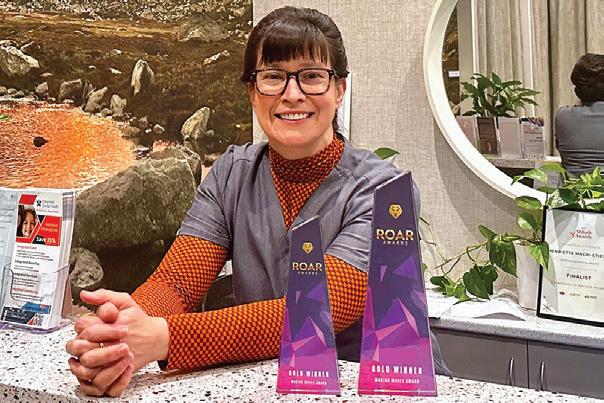
as possible, to remove fear from dentistry –dentistry without the dread.
“It’s so exciting – through the partnership with Smile On Clinics – to be able to
Sydney, Jervis Bay, regional NSW and Kalgoorlie in WA. It’s especially pleasing that we can now offer our world-class dental treatments to Canberrans in their








Okay readers, think of a political leader, local or federal, now or then. Done? Good. Now, what’s the one thing you know them best for?
Can you stretch that list to three? Hard, right?
Now, think about how long that person was in public life. Sometimes it’s decades. A life of sacrifice for whatever it is you can recall about them. That’s called legacy.
In a political leader’s career the aspiration is to move past the electoral cycle, or essentially just implementing promises that keep you elected, and emerge into the rarefied air of legacy defining.
Usually a political leader is only offered this chance through large majorities, both on the floor of a lower house and in the opinion polls. It is less mandate, more political capital. They want you to celebrate the achievements, live the aspiration and know and see that they changed our lives for the better because of what they did.
That political capital is essential, though. So often these legacy defining policies come with enemies internal and external, large obstacles and a team willing to sacrifice as much as you.
When we see this, it is amazing to think that a leader did this. For once,

for the greater good.
Examples? Gillard: Gonski and the NDIS. Howard: gun control laws that are the envy of the world.
The Prime Minister Anthony Albanese right now is entering that rarefied air. You can hear, see and feel it. He’s perhaps at a zenith very few leaders have reached this century. And yet this legacy defining term, that of the 48th Parliament, is also full of traps and obstacles.
If he can succeed at even just a few of the life-changing policies he’s now slowly letting us know about, then he may yet be the one leader we remember as doing the most. So what are those legacy defining policies?
The left, the now dominant faction
The speech the PM gave on recognition of a Palestinian state is one of the best I’ve heard this decade in federal parliament… Will there be dramas here? Absolutely. Not everyone thinks this is a smart move, great speech or not.
in Labor, were restrained in the first term as they worked on the long-play strategy of building trust in the Labor brand through effective delivery on election promises.
That restraint is now being lifted somewhat. First off was recognition of a Palestinian state. Conditional, yes, but long desired by many in the left.
The speech the PM gave on this issue is one of the best I’ve heard this decade in federal parliament. Rational, logical, well measured, a strong speaking style, it was the reminder of the steady hand in rough times he wants to be remembered as being. The Australian-centric PM. Will there be dramas here? Absolutely. Not everyone thinks this is a smart move, great speech or not. And, when it comes to the Middle East, there will always be dramas. But this one is ticked off early in the term.
Next, and not in any order, more opportunity. The Uluru Statement from the Heart will be implemented.
A First Nations Assembly is already being discussed, a treaty would be in draft somewhere secretive and, of course, a Makarrata Commission. Voice. Treaty. Truth.
How about constitutional recognition? If I was PM, I would implement the three pillars first, then seek a rerun of the Voice at a much later date, even if under a different PM. Once people see how Uluru would work in practice then, I’m guessing, most would understand and accept the constitutional recognition as being a logical step.
Closing the Gap and Reconciliation can’t wait much longer though for our First Nations peoples, especially here in the ACT where the gap numbers are shocking.
To the economy: nation-defining taxation reforms ARE coming. Governments nationally are broke (other than WA) and not getting better. The current business model is no longer fit for purpose. We either embrace austerity or change the system.
It is going to be a generational change and has to be linked to productivity to work. But if it does, we
will see a lower income tax burden, a more broad-based tax system, universal child care, governments paying less in debt and maybe housing fixed – it is the one key which opens so many other doors. Yet it will also burn the most capital and the hardest to knock off.
The work on this is already happening. The right faction is leading the effort, as they rightly sense opportunity for their leadership aspirants, notably Jim Chalmers, to publicly define how they see and may lead an Australia in the late 2020s/early 2030s.
Is there more? Should there be? For mine that is a legacy we will remember for a long time. Still hasn’t happened. Yet.
Special PS: shout out to BuzzzACT for a wonderful Science Week performance at Tuggeranong!
Dr Andrew Hughes lectures at the ANU Research School of Management, where he special ises in political marketing.
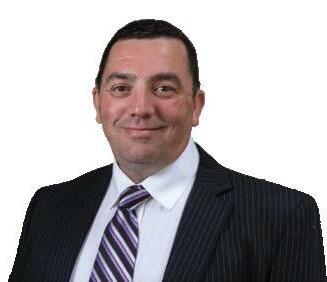

• Extensive range of nutrition products from Endura, GU, Hammer and Tailwind
• Come in and speak to our staff of Runners, Triathletes and Orienteers with a passion and a first-hand knowledge of our entire product range!





Beauty of the bush on display
ParkCare in Belconnen is showcasing the beauty and diversity of the bush in its annual display at Jamison Plaza, Macquarie, 9am-4pm, September 5-7.
The display features photos of the valley selected for the nation’s capital, cryptic wildflowers, eucalypt forest, box-gum woodlands and endangered grasslands.
Volunteers will share brochures, field guides, guided walks and interpretive signs to uncover bushland secrets.
Talking of stars
Astrophysicist Dr Brad Tucker will entertain the ladies of the Weston Creek View Club at their next lunchtime meeting at the Canberra Southern Cross Club, Woden, from 11.30am on September 2. Lunch costs $40 and interested visitors are welcome. RSVP to 0408 864616 by August 27.
Dancing with a star
Folk Dance Australia, in conjunction with Folk Dance Canberra, is hosting a weekend dance workshop with Lee Otterholt, recognised as one of the foremost teachers and choreographers of recreational world dancing. He will teach a range of dances suitable for beginners and intermediate students at Folk Dance Canberra Hall, Hackett, over the weekend of September 20-21. Book at

The onset of unexpected library closures across the ACT, apparently due to lack of relief staff, is alarming and disappointing.
It has been a regular occurrence at my local Kippax library. The ACT system, unfortunately, has no independent library board, as is commonplace elsewhere.
The role of libraries must also be seen as community hubs with lifelong learning activities. Moreover, there are currently relatively few professionally trained staff with qualifications for these tasks.
Furthermore, many areas of Canberra still do not have libraries-cum-community centres, eg the Molonglo suburbs. They are so necessary for education and voice in each of Canberra’s regions.
A public hearing investigating the situation with ACT libraries, by an Assembly committee, is long overdue!
Dr Chris Watson, via email
Hanrahan
Wonderful to read how Canberra local Dr Susan Orgill is helping farmers store more carbon in soil (“Passion for making soil a sexy subject”, CN August 7).
Globally, up to 10 gigatonnes of CO2 will need to be removed annually by 2050.
The CSIRO estimates that Australia could sequester 5-29 megatonnes a year in soil, with additional potential from farm forestry and land regeneration.
Yet some correspondents (letters, CN August 7) still deny this science or the need for it. Dave Jeffrey cites the 1921 poem Said Hanrahan as evidence “nothing has changed over the last 100 years”, while Anthony Hordern claims only three per cent of atmospheric CO2 comes from “wayward human activities”.
In fact, the CSIRO explains: burning fossil fuels adds an extra 9.1 billion tonnes of CO2 to the atmosphere each year. Of this, 2.8 billion tonnes are absorbed by plants and soil, 2.2 billion tonnes by oceans, but 4.1 billion tonnes remain, driving up CO2 concentrations.
This excess is what fuels global warming. As a result, over the last 100 years, average temperatures have risen nearly 2°C and sea levels by 20 centimetres. Hanrahan would indeed be worried.
Amy Blain, via email
Canberra CityNews should stand proud for how its columnists have over the last few months so eloquently drawn attention to the fact that the ACT has the highest indigenous imprisonment rate of any state
or territory in Australia.
This highest rate translates into additional and tragic deaths in custody.
In my ignorance, I had simply assumed that the ACT had the lowest indigenous imprisonment rate. I am now better informed. CN proudly leads the way in breaking important news. I need only mention Robert Macklin in 2019 breaking the news of a secret trial and imprisonment in the ACT that not even the ACT attorney-general was aware of.
I suspect that CN’s radio advertisements in fact understate the high quality of what it has to offer.
John Burge, Curtin
Gosh golly. Sue Dyer, of Downer, (“Throwing the Bach out with the bathwater”, letters, CN August 7) has seriously mistaken the role of today’s universities.
In the pursuit of excellence they have the important educational tasks of defining what a woman is, teaching Aboriginal mathematics and advancing grammar by correctly defining personal pronouns.
Universities really don’t have the time or finances to fuss about with such Western Enlightenment nonsense as Bach’s or Beethoven’s music. And anyway, there are loads of contemporary guitar and drum thrashers out there who “do” music.
Anthony Hordern, Jamison

In our submission to the recent inquiry into bail in the ACT, my co-writer argued for Electronic Monitoring (EM) to be introduced for offenders and alleged offenders.
As we know, there are almost no rehabilitation programs at the AMC. Would it not be better then to use EM and access support services in the community?
Not that long ago, I was told by two MLAs that EM would be implemented, and plans were being made.
How disappointed I was to read “there’s no money in the ACT 2025-2026 budget to implement the scheme, with leftover previous money still being used to conduct feasibility studies and ongoing policy work”.
Really? The studies have been done elsewhere. The necessary policies can be copied.
I had a think about it, and then the penny dropped; the ACT is broke, due to Andrew Barr’s refusal to call time on the light rail debacle.
So, I guess we ratepayers are saddled not only with the interest payments on the trams we can’t use, but also maintaining the most expensive, but non-productive prison system in the nation.
Makes me embarrassed to be a Canberran – a city that has a government incapable of admitting failure and making sensible plans for our future.
Janine Haskins, prison reform advocate
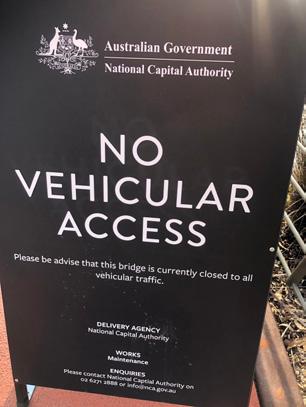
We are in a glasshouse when it comes to throwing typographical bricks at anyone else, but… an irresistible note and photo arrived from a reader who spotted a howler on two identical signs, back-to-back, plonked on the Burley Griffin lakeside central basin footbridge near the statue of Menzies.
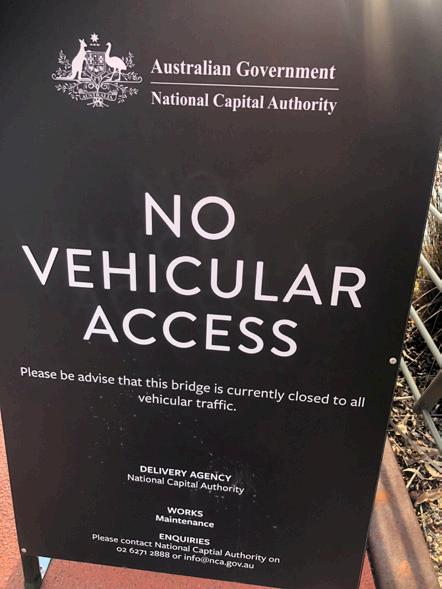
With the authority of the National Capital Authority, it warned that “no vehicular access” was permitted, but then in a burst of unnecessary pseudo politeness, says “Please be advise…”, sinking its authority with a missing “d”.
“Perhaps the NCA should be renamed the ‘Notional Capitol Authirty’,” writes our wag.




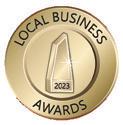


May Fiona Carrick keep raising public awareness as she wades along the path of analysis and exposure (“Independent exposes Steel’s shonky budget ruses”, CN July 31).
Hopefully she and her MLA colleagues on the Assembly’s MyWay+ debacle inquiry will also be aware by now that there is still a lot not working, let alone well, in the public bus system, nearly 10 months after the new transport ticketing setup was lobbed at drivers and the travelling public.
It is clear that the treasurer, who is also the transport minister, is prepared to keep funding only substandard bus service operations and maintenance after the sub-par yet costly introduction of MyWay +.
Ad hoc bus trips in the past two months have revealed that on-board ticket read ers are frequently out of action. On one fairly new bus, the reader also inexplicably broke down during a three-kilometre trip. Tapping on but then not being able to tap off has financial and tedious follow-up implications for the travelling public.

Both the reader and the on-board visual display screen of upcoming bus stops were not working on a recent nighttime bus trip. Many of the 20 or so passengers tried to peer out of reflectionfilled windows, wondering where on earth the stops were as the bus wound its way through low-lit suburbs.
In addition, enduring the worsening level of amenity and sense of security at bus interchanges, especially at night in Civic and Dickson, is not helped when all the digital display boards of expected bus arrival times are still out of commission.
Mercifully, though, the incomprehensible and aggravating on-board voice-over descriptions of upcoming bus stops by their four-digit number now appear to have been removed from earshot.
Why was such poor-quality and useless audio reception not picked up in a testing phase across a range of buses? How much did this failure cost?
The transport minister finds it easy to blithely talk up public transport use but still appears reluctant to communicate openly and honestly about fixing the deficiencies that still plague the public bus service’s ticketing reforms and ongo -
ing operations.
It is time that the overly light rail-focused Labor government worked much harder to make bus travel a far more appealing and convenient way of moving around the national capital, day and night.
May the MyWay+ inquiry produce a comprehensive list of fast-tracked, yet well-tested operational rectifications and longer-term actions that need to be committed to and regularly reported on.
Sue Dyer, Downer
Global heating is driven by the top 10 per cent of emitters, who cause 30 per cent of annual emissions. Australians are in that top 10 per cent.
The Commissioner for Sustainability and Environment tells us that the ACT’s per capita carbon footprint is higher than that of any Australian state.
The new Chair of the ACT Climate Council thinks that Canberra needs to plan for temperatures up to 55C. If the rest of the world follows our example, those 55-degree days will arrive even sooner.
We of the top 10 per cent can cut the
world’s emissions by one fifth, by simply bringing our emissions down to the world average. The ACT government’s “zero net emissions” target applies only to Scope 1 emissions.
The Commissioner says that 94 per cent of the ACT’s emissions are Scope 3. She made 12 recommendations for addressing Scope 3 emissions. The ACT government agreed to act on only one of those recommendations, to “talk to other states and territories to ensure progress is taking place across Australia”.
Climate Action Canberra is a member of the ACT-government-funded Conservation Council ACT Region. We do not endorse the council’s claim that Canberrans are proud we are leaders when it comes to climate action.
Leon Arundell, Climate Action Canberra, Downer
Re Ray Peck’s letter “We prefer sunshine to fission” (CN August 7): I’d like to know what Ray means by “even ordinary Australians are not keen” referring to nuclear power. What is “an ordinary Australian”?
As to the surveys, it depends on who is doing the survey. If wind turbines are so popular in the surveys, why are there so many protests about the on and off-shore turbines?
Regarding the results, I have seen surveys where people prefer nuclear power because it is available 24 hours a day 365 days a year.
Nuclear plants last about 60-80 years, whereas solar and wind last 10-15 years.
Minister Chris Bowen has never given the true cost of wind, solar, power lines, firming, and all the incentives, plus the fact they will have to be replaced. If nuclear power is so unpalatable, why is the rest of the world switching to nuclear?
Vi Evans, via email
Michael Moore’s rant on the ACT’s indigenous incarceration rates disgrace (“Labor finally lines up to face indigenous disgrace”, CN August 7) comes as no surprise, nor does his observation that action on this travesty is long overdue.
We need only go back a few years ago when one of our great newspaper cartoonists had a cracker showing two tough-looking, black-clad prison officers wearing silver reflective sun glasses in a fenced-off area with one saying: “There’s a lot of them in here these days” and the other replying: “Yes, that’s because more of them are getting caught”.
The lockup rates have nothing to do with the ACT Labor Party as Moore suggests; it’s all about a minority failing in the appreciation of civilised, commonsense law.
John Lawrence via email
Canberra has a terrific road system – it was built that way. It is not a city where you commute into the centre by day and return home at night. The satellite town centres and distributed work locations mean that traffic is moving in large volumes in all directions, all day, every day.
I am no transport expert, but I can’t understand how an elected government of sensible people could come to the conclusion that a fixed-line rail system – built at an incredible cost – would have any meaning -
ful contribution to the daily workings of this wonderful city.
A woeful decision that the next generations will have to pay for and for which no-one is held accountable.
Peter Claughton, Farrer
In Michael Moore’s August 14 column addressing atrocities from around the world under the headline of “How do people treat each other so Abominably” he says: “The images reveal returning to a time where some people have no humanity for others, no compassion
“In Australia, and perhaps in Canberra specifically, we have the good fortune to look through a very privileged lens at the rest of the world.
“It is incomprehensible, when looking through this lens, to understand how people can treat each other so abominably. Starving and killing babies, small children and teenagers is simply barbaric.”
He finishes his article with: “We should expect more humanity and compassion from the Australian people and especially from our governments”.
I agree, we should expect more humanity and compassion and stop killing innocent babies through abortion.
Bob Wilson, Kambah
I’ve lived in Canberra for three years (loving it, thanks for asking), have yet to catch a tram, but with the traffic chaos around light rail construction, it’s hard to ignore.
Can’t be easy developing new public infrastructure. Jon Stanhope and Khalid Ahmed’s Stage 2b autopsy report (CN August 7) confirms that the operators won’t make a profit.
They also dance around procurement procedures. No actual suggestion of anything dodgy, just that the auditor-general’s eyebrow might be raised. So what?
These fine authors have put hours of research and analysis into dissecting the scheme – it took almost as long to read – but if the scheme is as bad for Canberra as they imply, what’s their solution? Are they just closing the stable door?
Dick Bauch, Latham


Cutting the Australian National Dictionary Centre at the ANU isn’t just a short-sighted administrative decision to save a few quid, it’s the wilful disregard of Australian cultural heritage, say HOWARD MANNS and KATE BURRIDGE .
Bonzer. Dinkum. Troppo. We love our distinctive words and phrases.
We revel in the confusion they cause outsiders. We celebrate the stories behind them. We even make up a few furphies about them.
For nearly 40 years a dedicated team at the Australian National University has been hard at work digging up these past stories – real and furphy – and keeping a close eye on the new ones.
Most everything you know, want to know, or have heard about Australian words comes from the Australian National Dictionary Centre (ANDC).
But despite this work, and the central (and government-funded) role the ANU is meant to play in Australian history and identity, the ANU leadership is killing off the ANDC. The university has stated that the decision is a necessary part of reducing operating costs.
Dictionaries help define and reflect a nation’s identity. When Samuel Johnson published his famed Dictionary of the English Language in 1755, many celebrated that he and a handful of assistants accomplished
in nine years what took 40 French academics half a century.
Dictionaries are especially important for colonial Englishes, such as those spoken in many countries, including Australia and the US.
Australia’s colonial English got off to a slow start – dismissed as “the base language of English thieves” and “crude, mis-shapen and careless”. But by the late 19th century, Australians began celebrating their distinct words, in the Bulletin, in books like Sidney Baker’s “The Australian Language”, and in dictionaries such as EE Morris’s “Austral English”.
Still, many called for a truly national dictionary to capture the way Australians speak. Australian lexicographer Peter Davies wrote in 1975: “Vigorous cultures demonstrate pride and interest in their own languages and literatures by building great works in their honour.”
Finally, in the 1980s, Australians stopped taking their linguistic cues from Britain. With the publication of the Macquarie Dictionary in 1981 and the Australian National Dictionary in 1988, the language found its local voice. However, these works differ in how

they approach Australian English. The Macquarie Dictionary describes the spelling, pronunciation and definitions of English words as they are used in Australia.
The Australian National Dictionary (AND) grounds our words, and their meanings, in their historical and cultural contexts. The AND tells us where words have come from, when they were first used and how their meanings have changed over time. In short, the AND is a living, breathing and evolving record of how language is wrapped up in who we are as Australians.
As linguist Don Laycock once wrote: “There’s no other dictionary quite like this one in the world”. Its pages sing of “boundary riders, larrikins, sundowners, fizgigs, diggers and other dinkum Aussies”. Sidney J Baker argued if the “Australian language [was] something
to be reckoned with it” it was because of these iconic characters.
But the dictionary’s first editor, Bill Ramson, was not as romantic as Baker. Ramson wanted an academic and historical work – he left the romantic side of Australian English to the rest of us.
As an academic work, or more accurately, a monument to Australian English, the AND is unparalleled. Its second edition, released in 2016, contains the history of more than 16,000 words and phrases. Moreover, the second edition did the hard yakka to acknowledge the influence of indigenous words on our English (words like “yakka”, from the Yagara language).
But the AND is more than an academic resource – its insights inform media, education and everyday life. We (the authors) write and speak widely about Australian English, with hundreds of media appearances each year, and we’ve both authored high school texts exploring its history and use. Crucially, the AND’s research doesn’t just support this work – it makes it possible.
When the Australian National Dictionary was first published – by Britain’s Oxford University Press –some baulked at foreign involvement.
In 1983, Australian publisher Kevin Weldon even called it “the most unpatriotic thing ever”, also objecting to it being edited by a New Zealander
(Bill Ramson) and an English woman (Joan Hughes).
History, of course, has vindicated them – and the many others, Australian or not, who helped create this cultural landmark.
But Weldon was not necessarily wrong. In the end, it seems Americanstyle managerialism will be the death of the ANDC. Weldon surely didn’t anticipate that the “most unpatriotic thing ever” – the killing off of the AND – would be an act by Australians at the Australian National University.
In a statement, the ANU told The Conversation: “This decision reflects the need to reduce recurrent operating costs while ensuring that core academic activities are sustainably embedded within Schools and Colleges”.
Cutting the ANDC isn’t just a short-sighted administrative decision to save a few quid. It’s the wilful disregard of Australian cultural heritage and the powerful work its scholars do to help us understand the past, present and future of Australians, our English and our identities.
This dictionary centre is a national asset – once it’s gone, we lose a living record of our national voice.
Howard Manns, senior lecturer in linguistics, Monash University and Kate Burridge, professor of linguistics, Monash University. Republished from The Conversation.



At some point, everyone needs a quick storage solution. From home office supply storage, off-site solutions while downsizing or decluttering or handy storage tips and tricks to make a move as seamless as possible. Whatever it is, Canberra is home to many services that can help with a big move, or with storage options for onsite, offsite, in-the-home or backyard.
“For Canberrans looking to renovate, storing excess belongings can be a convenient, secure and affordable fix,” says Self Storage Solutions manager, Lewis Jones.
A family-run business for more than 30 years, Lewis says they are proud to provide cost-effective storage options for people living in regional and metro communities, and can help get quotes from trusted local removalists.
“Our monthly storage costs are easily half the price of a storage unit in Canberra,” he says.
“People generally like a single garage-sized unit, and in Canberra and Sydney that can easily be $800-900.
“We have customers from the Snowy
Mountains all the way to the northern beaches of Sydney and operate in a location that’s really convenient for customers and removalists.”
Currently running a special from $279 for units the size of a single car garage, Lewis says they can hold more than 40 cubic metres of items.
“We take pride in providing excellent customer service and looking after your property while it’s in our care,” he says.
Self Storage Solutions currently have 11 vacant units from $279 that will be available for the special offer until the end of September.
Self Storage Solutions. Call 02 9986 3618 or visit selfstoragesolutions.com.au
Out with the old and in with the new can be an exciting but daunting step for any office space.
Moving, upgrading or ending an office lease can be expensive, with removalists costing a pretty penny, which is where the boys at Ex-Government Furniture can help.
“We provide a pick-up service for unwanted furniture that will save you a bucket load of money in comparison to other removalists,” says co-owner James Fullerton.
Not limited to government facilities, James says their pick-up service is open to private businesses as well.
Selling furniture at their warehouse in Fyshwick, James says they travel at least once a week to pick up unwanted furniture, creating a constant turnover of items.
“We have all kinds of affordable office equip ment,” he says.
Seeing a rise in customers looking to upgrade their work-from-home office set up, James says they’ve also seen an influx of secondhand bookshelves, storage solutions, sit-stand desks and chairs.
“We’ve also seen some really nice Italian and European leather chairs enter the store,” he says.
“These will last a lifetime in a household.”
“No one wants their home to feel like an office, so we’ve got storage solutions for that too, all for the fraction of a price of something new,” says James. Ex-Government Furniture, 26 Molonglo Mall, Fyshwick. Call 6280 6490 or visit exgovfurniture. com, facebook at exgovfurniture or on instagram at exgovfurniture

•
• Yes we have Caravan, Boat, Trailer & Car storage available!
•




From home organisation, moving, spring cleaning or restoring order, cleaning can be a hard task to tackle.
Harmony in the Home owner Laura Cooksey says her cleaning service handles the work with care, dignity and discretion.
“You can’t do your job without compassion,” she says.
A family business specialising in the “big things in life”, such as bereavement, hoarding, movement into a nursing home and deep cleaning, Laura says they handle everything, from sitting down with the owners to emptying and clearing a house for sale.
“We take the time to understand our clients,” she says.
“What might look like nothing to one person has a deep emotional attachment to another.
“It’s an individual process, and although you can’t always leave with everything, it’s important to understand how important pieces are to each person.”
Working directly with the family or owner, Laura’s services extend beyond everyday cleaning as a pillar of support during life’s overwhelming moments.
“Every person is different, and sometimes that means that they’d like to be included in the process to review each item, helping identify if it gets donated, sold, passed on or thrown away,” she says.
Harmony in the Home. Call 0494 061961 or visit harmonycanberra.com

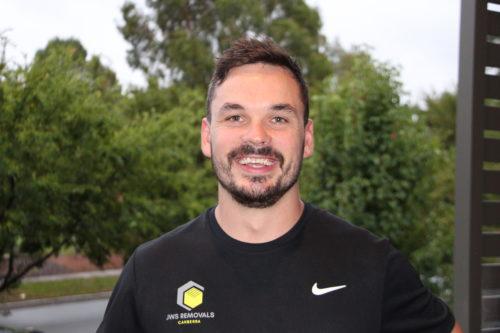
WITH a focus on care, professionalism, reliability and efficiency, JWS Removals is Canberra’s removalist of choice, says owner Jack Stafford.
Jack, who’s been specialising in furniture removals, logistics, as well as fine arts and antique relocations, for more than 10 years, established JWS Removals to fill a gap in the industry, offering a more personalised removalist service.
Being a small, privately-owned and operated business, Jack says he works with clients personally, from the quote all the way through to the unload.
“We pride ourselves on our professionalism and that’s why we don’t use labour hire, only quality, experienced removalists who know how to get the job
We’re a small, family-run business here to bring a little more peace and balance to your home. At Harmony in the Home Canberra, we offer friendly, practical support through thoughtful decluttering and organising. Whether you’re going through a big life change or just need a hand keeping things on track, we’re here to help create a space that feels calm, clear, and truly yours.





done right,” Jack says.
“We leave nothing to risk, using specialised furniture blankets, boxes, plastic furniture protective covers, trolleys, carpeted truck floors, felt pads for in-home floor protection and much more to ensure a risk and stress-free move.”
And, so there’s no hidden costs, JWS Removals offers in-person, no-obligation, free quotes.
This also allows Jack to see the furniture and valuables in advance so he knows exactly what protective materials are needed to make the move as quick and safe as possible, he says.
JWS Removals. Call 0448 401604 or visit jwsremovals.com.au
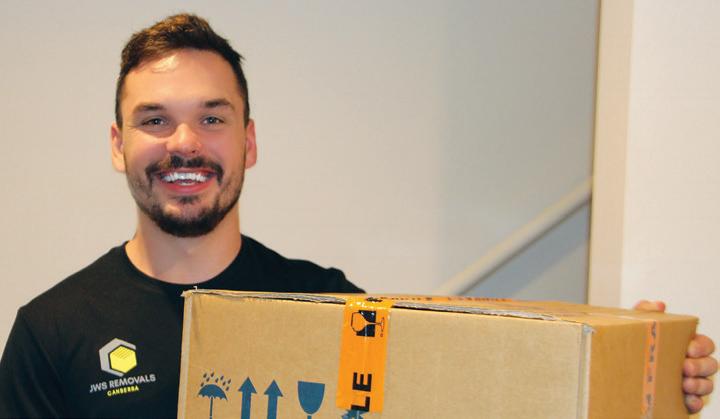


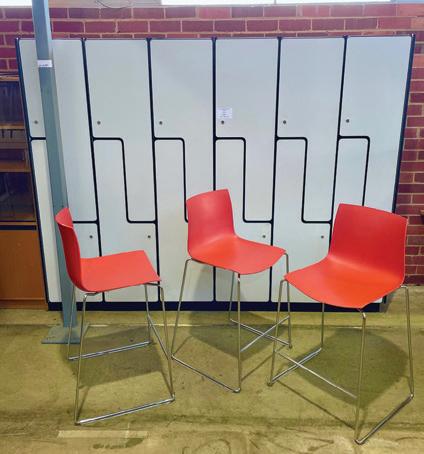
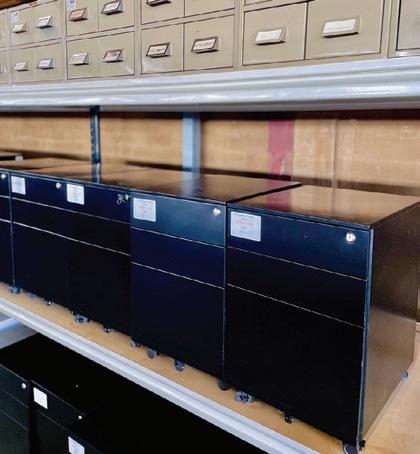
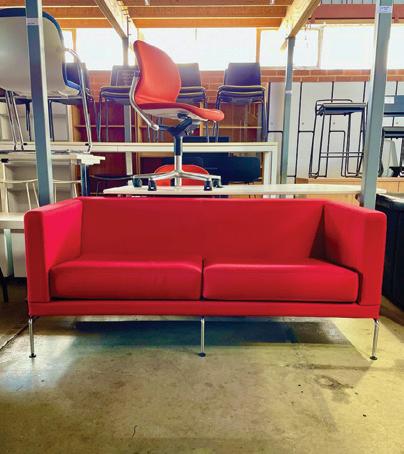








Brewing Co. founder Richard Watkins.
to time, says BentSpoke Brewing Co founder Richard Watkins, but most of them haven’t had the chance to learn how a beer is actually made.
brewery tour of the Mitchell facility and an Oktober fest-inspired lunch and tasting session at its brew pub in Braddon.
manufactured, right from the grains that are used to make the beer, through to getting the beer into a can or into a keg,” he says.
“And talk about the flavours in the beer and dissect the beer into its components, and hopefully the dads will learn a little bit more about beer.”
Richard says he has been brewing beer for 30 years,
“We just love beer,” says Richard. “We just love the

“Sometimes people find it hard to have a conversation, and so many good conversations, and meaningful
company, we create jobs in Canberra, we support the Canberra community.”
Bentspoke Brewing Co., 38 Mort Street, Braddon. Call 6257 5220 or visit bentspoke brewing.com.au.
Lolly Swagman has been excitedly exploring new tastes for nearly three decades, says owner Ian Richardson.
Located in the heart of the Southern Highlands, the lolly shop stocks all-time favourite treats and the latest trending tastes from around the world, and offers the perfect excuse to go on a roadtrip with dad.
“We’ve got American Reese’s, Hershey’s and candy corn, English bon bons and chocolates, sours and super sours, Dutch liquorice, Scottish tablet and our own Mrs Swag’s Fudge,” says Ian.
“We lost count at 1300 different treats and we know it’s more than that.”
Ian says the store has something for everyone, and is a great place to bring dad to get completely spoiled on Father’s Day.
At the moment, Ian says they have been particularly enjoying the new Peaches and Cream and Chocolate Ginger hard lollies from Blackebys Sweets, in SA.
Ian says Blackebys still use the copper pans from the 1880s to make lollies in the traditional way, and Lolly Swagman has a sizable collection of their treats.
“It’s a happy place with kids excitedly exploring for new tastes, older people reminiscing and sharing in the thrill of finding a favourite and the great stories that go with them,” he says.
“We often see people who’d come as children now bringing in their own children and sharing their experiences, which is lovely to be allowed to join in on. It’s nice to have that history.”
Lolly Swagman, 11 Old Hume Highway, Berrima. Call 4877 1137, or visit lollyswagman.com.au
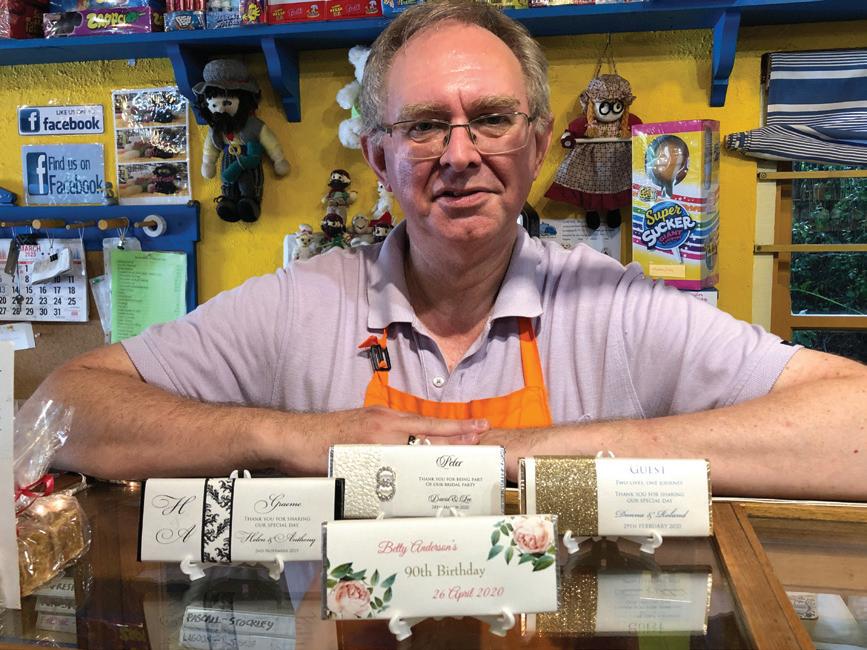
SUNDAY, SEPTEMBER 7



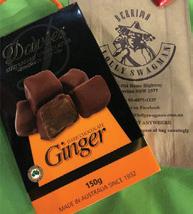
Creating work opportunities for those living with disabilities, Embrace Disability Group founder and CEO Matt Morrissey says they created The Dugout in Jerrambomberra after identifying a gap in the hospitality industry.
This year, Matt says they will host a barbecue feast at The Dugout on Father’s Day,
“We’re bringing the heat with a smokey, flavour-packed celebration that’s all about good food, cold drinks and great company,” he says.
The Dugout will host two lunch sittings from 11.30am-1.30pm and 2pm4pm. Book for lunch at 6140 3258
“No one does the work that we do,” he says.
With 18 students currently undertaking training and 68 who have been employed after working with the program, Matt says they firmly believe that an inclusive society is a stronger and more vibrant one.
Specialising in training, cooking classes and work opportunities, Matt says they are not restricted by age or ability to join.
“We empower individuals with disabilities by providing meaningful employment opportunities within our catering business,” he says.
“We currently have nine canteens across Canberra.”
The Dugout. 210 Environa Drive, Jerrabomberra NSW. Call 6140 3258, email hello@ embracedisabilitygroup.com.au or visit embracedisabilitygroup.com.au
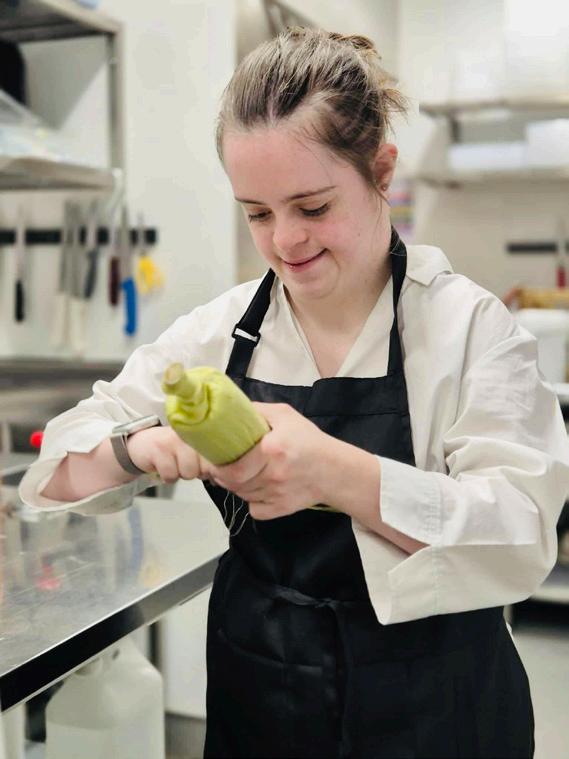

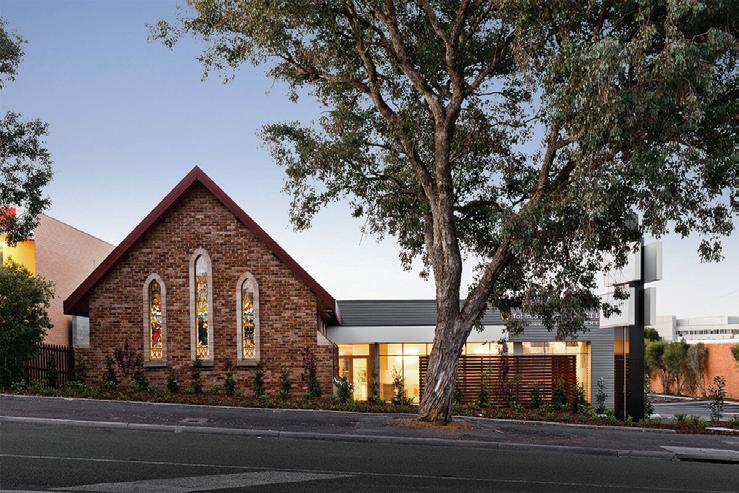
This Father’s Day, Tobin Brothers Funerals Belconnen will be hosting a memorial service from 5.30pm to 7.30pm on Wednesday, September 3.
“The event will be a thoughtful evening of remembrance in honour of fathers and father figures who have passed,” says Cassandra Proctor, operations manager for Invocare ACT, the parent company of Tobin Brothers.
“This service is more than just a remembrance, it’s a celebration of the indelible impact these men had on our lives.
“It’s a chance to acknowledge the pain of loss while finding solace in community and shared memories.”
An opportunity to honour and remember the fathers, grandfathers and special men whose “influence continues to shape our lives”, Cassandra says guests are welcome and encouraged to bring a photo of their
loved one to be included in a memorial display.
“The service will be led by Canberra celebrant Michael Bower, who will provide a safe space for reflection and remembrance,” she says.
“Attendees will be invited to write the names of their cherished loved ones on memorial cards, which will be respectfully burned for their ashes to be scattered in our rose memorial garden.
“All are welcome to join us for this meaningful occasion to celebrate and commemorate the fathers who are no longer with us today, but still hold a special place in our hearts,” says Cassandra.
Canapes and light refreshments will be provided.
Tobin Brothers Chapel. 101 Nettlefold Street, Belconnen. Call 6251 2344 or visit tobinscanberrafunerals.com.au. RSVP by August 27 to actoperations@invocare.com.au
This Father’s Day, ditch the socks and serve up something he’ll actually love –a BBQ feast at The Dugout!
We’re bringing the heat with a smokey, flavour-packed celebration that’s all about good food, cold drinks, and great company. Whether Dad’s a steak man, a sides king, or just in it for the burnt ends and banter – this one’s for him.
treat: All Dads receive a complimentary beer, wine or soft drink on arrival – because heroes deserve to be toasted.

Wednesday 3 September, 5.30-7.30pm
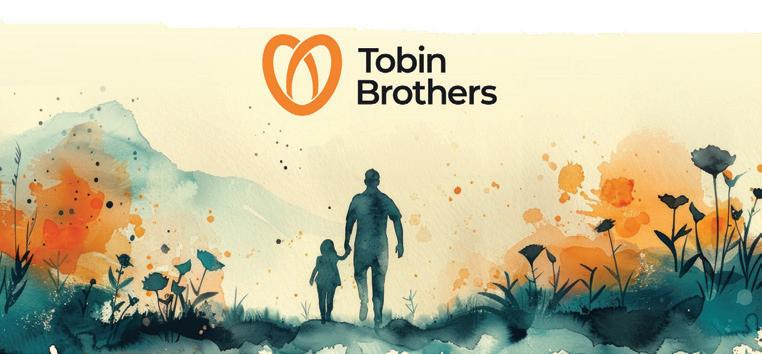
At Venetia Major – Bespoke Jewel lery in Hall, every piece is designed to tell a story.
Owner and master jeweller Venetia Major specialises in creating jewellery that reflects her clients’ styles and sentiments.
From the first sketch to the final polish, each design is crafted with care and meaning.
“Whether it’s breathing new life into a family heirloom, repairing a much-loved piece, or starting fresh with a new design, we create jewellery that is truly individual,” Venetia says.
Clients are encouraged to bring in anything – from old, broken jewellery to loose gemstones and odd bits tucked away in jewellery boxes.
“No need to clean or sort beforehand,” Venetia says.
“We’ll take care of it, and we even offer scrap credit for any precious metals not used in the final piece.”
While remodelling is a special ity, Venetia also creates bespoke engagement rings and one-of-akind designs, sourcing diamonds and gemstones or working with stones supplied by her clients.

“Our diamonds are of the highest quality and set with expert precision, designed to radiate brilliance for a lifetime,” she says.
“Clients can choose their preferred metal, gemstones, and
design details to create something truly personal and enduring.”
Venetia Major – Bespoke Jewellery, 3/8 Victoria Street, Hall. Call 6230 9587 or visit venetiamajor.com.au
Family owned and locally operated, Total Body Contouring owner Christy Christensen says she is proud to be working with cutting-edge technology to help Canberrans feel like the best version of themselves.
“We are Canberra’s trusted local choice for body contouring, offering expert care and results our clients love,” she says.
With years of collective experience within the organisation, Christy says they are constantly keeping up to date with new and revolutionary technology to create a pain-free experience.
Currently offering a $300 fat freezing treatment using Cooltech technology, Christy says they can target up to 40 per cent of fat in the area within two to three months of use.
“There’s no downtime required,” she says.
“It’s non-invasive and we provide free consultations prior to treatment.”
Total Body Contouring is also the only Canberra organisation to have an emerald laser.
“The emerald laser is a non-invasive, FDA-cleared,
fat-reduction treatment that uses low-level green laser technology to shrink fat cells without pain or downtime,” says Christy.
“It is suitable for individuals with a BMI up to 40 and helps reduce body circumference safely and effectively,” says Christy.
“With no bruising or swelling, it’s a gentle and convenient option
for those seeking non-invasive body contouring.”
Exclusive to Total Body Contouring, Christy says the technology benefits fat loss and enhances how clients feel about their body.
Total Body Contouring, Shop 3/22 Franklin Street, Griffith. Call 6239 7347 or visit totalbodycontouring.com.au









In the heart of Manuka, ACT, Stephanie’s Boutique Lingerie stands as a beacon of comfort, quality and confidence in the realm of intimate apparel, says owner Fil Barilaro.

“With a focus on perfect fitting underwear and personalised bra fitting services, Stephanie’s store has earned its reputation as a haven for those seeking comfort without compromising style.”
According to Fil, the importance of perfectly fitting underwear cannot be overstated.
“Ill-fitting undergarments can lead to discomfort, posture issues and even skin irritation,” she says.
Bringing more than 20 years of experience of bra fitting with her, Fil says the result of properly fitted undergarments creates a level of ease, comfort and support that allows clients to carry themselves with confidence.
Beyond the physical benefits, Stephanie’s Boutique also offers an extensive range of high-quality, carefully curated brands.
“From luxurious lace to everyday essentials, the store boasts an array of options that cater to various tastes and lifestyles,” says Fil.
“Stephanie’s Boutique is more than just a store; it’s a testament to the power of personalised care in the realm of intimate apparel.
“In a world where comfort and confidence go hand in hand, Stephanie’s expertly curated selection and fitting services have become a cornerstone destination for beautiful women across the ACT.”
Stephanie’s Boutique and Lingerie. 7 Manuka Arcade, Manuka. Call 6295 0469 or visit stephaniesboutiquelingerie.com.au



Stephanie’s Boutique Lingerie is located in Manuka Arcade and welcomes you to call in and browse the wide range of new season stock, make an appointment for a personalised fitting













By Jackie WARBURTON

With spring just around the corner, it’s seedsowing time. This is an exciting process and a great way
Seed can be sown in seed-raising mix and kept on a heat pad for fast growth or on a sunny window sill indoors but as a general rule, the larger the seed the larger the pot and the bigger the seed the easier to raise.
A pot for raising seed should be shallow. It shouldn’t have fertiliser in it and have quick drainage.
Vegetable seeds that can be sown now include beetroot, leeks, lettuce, peas, silverbeet and snow peas. Sprinkle seed lightly over wet
seed-raising mix and press down so the seed is in contact with the media.
Lightly cover with washed sand and water lightly with a watering can. Water little but often. Be careful not to overwater.
Summer flowers that can be sown now include zinnias, cosmos, nasturtiums and sunflowers.
Zinnias’ flower colour range is vast and vibrant. Available as large flowers, they offer contrasting colours that give any corner of the garden some bling.
The range of cosmos has also improved over the years, and the shapes of the petals are just so pretty. My favourite new-release cosmos with saucer-shaped flowers is called Cosmos Fondant Fancy.
The softness of the pink is really lovely and it flowers for many months. Like all cosmos, it’s terrific at attracting pollinators.
Nasturtium and sunflowers are easier to sow as the seed is much bigger. As a general rule, plant it



twice the depth of the seed and cover lightly.
They both need water in the warmer months but if kept well-watered they will flower right through to autumn and, once sunflower seeds are ripe, they will attract rosellas to the garden to feast on them.
Sowing a punnet of seed every few weeks will extend the flowering and fruiting time in the garden over the summer and autumn season.
Using heirloom seeds will be an added bonus as the seed can be kept for sowing next season. Most seed bought in packets that are displayed as a “F1 Hybrid” means that the seed is sterile and will not re-produce the same plant.
CEANOTHUS, a small tree that went out of fashion for a few years, is back as a drought hardy plant and in more varieties.
It has the most intense blue flowers in spring and will survive with little or no water once established.
It doesn’t mind the full sun or a bit of shade.
A small, evergreen, quickgrowing tree, it grows to about three metres tall and wide. Its lifespan is only 10-15 years.
There are many shades of blue ceanothus now available as well as white and pink, but the cobalt blue Pacific is my favourite in the
tree form.
New to the species is the dwarf and ground cover ceanothus Pacific Wave that only grows to 60 centimetres tall. It has beautiful, soft, light-blue flowers.
Ceanothus don’t like lime so keep them growing with camellias and azaleas with lots of compost and feed once a year with acid fertiliser.
CAMELLIAS that are in bud or in flower will benefit from a little bit more water as they are shallowrooted plants and can dry out quickly. If there are big clusters of buds on camellias, disbudding can be done, and some can be removed to allow room for other buds to grow and prevent fungal issues. This practice also encourages the other blooms to grow larger and of better quality.
jackwar@home.netspeed.com.au
• Fertilise peaches and nectarines as they wake from winter.
• Prune hydrangeas for summer flowering.
• Sprinkle some lime on peonies to keep the soil sweet.
• Spray stone fruit trees with cop- per to avoid peach leaf curl.




By Helen MUSA

Juliet. Not quite 14 years old – so young, so impetuous, and yet so intelligent and wise beyond her years.
It’s a dream part for any aspiring female actor and it’s the perfect answer to complaints that Shakespeare didn’t write good enough roles for women.
So enticing is the 13-year-old Juliet in fact, that she’s been played by famous British actresses well into their 60s.
When I catch up with Madeline Li, who’s taking on the role in Bell Shakespeare’s revival of Peter Evans’s 2023 production, I find that she’s much nearer the fictional Juliet’s age.
A graduate of the National Institute of Dramatic Art (where she got to play roles as challenging as Juliet, such as Elsa in the Danish drama, Festen, and Irina in Chekhov’s Three Sisters), to her mind, Juliet’s age is not front and centre.

how old Juliet is in the play – “not yet 14.”
When I catch up with her, they’re halfway through the second week of rehearsals and have been focusing on matters different from the sociology of Juliet as a young teenager.
As with Hamlet, aged 30, we know exactly
To be sure, people are aware of her age, but the idea of adolescence is a modern one and as Li says: “We don’t have to play into that when we perform the character, even though young people today often read her sympathetically because they’re going through adolescence.”
Besides, it’s obvious to anyone that Juliet is much more mature than Romeo, whose part falls to Ryan Hodson.
Li is not quite a newcomer to Bell Shakespeare, having made her debut with them in their poetry-based show, In a Nutshell, “a crash course in Shakespeare”, she says. Well, not quite. She did play Helena in A
Midsummer Night’s Dream at NIDA.
When tackling Juliet, she says: “One thing I was aware of is that she changes her mind a lot – sometimes she’s pragmatic and sometimes she’s romantic. It’s a real push and pull.
“The more I discussed it with Peter [Evans], the more I saw that her pragmatism was in service of her romantic side.
“I feel that her idealism comes through as the play moves through the misunderstandings that bring about its tragic end.
“The extraordinary intelligence she reveals by showing confidence in her feelings for Romeo are a difficult thing to do at any age and are a really beautiful part of her character.
“From the first day of rehearsals, I felt that they were both zealots in their love… to me, to worship another person and show the way you feel is a really admirable thing.”
Li agrees that Juliet is canny enough to seem to play the game as she does when she pretends to give in, agrees to marry Paris, and asks for permission to go to the Friar (Khisraw Jones-Shukoor) for confession.
She has wisdom beyond her years, Li says, but she is unchangeable in her love.
Her view of the play is generally a positive one and she looks upon Lord Capulet’s (Michael Wahr) violent outburst when Juliet refuses to obey him as a momentary aberration that follows the death of his kinsman Tybalt (Tom Matthews).

“It’s the first time he’s ever behaved like this and it gives us a chance to look at how people behave in times of great grief,” she says.
Noting that Juliet’s father doesn’t know about her relationship with Romeo and her reactions to his banishment, she says: “He definitely doesn’t act like a loving parent, but he’s only human.”
Romeo and Juliet is a tragedy based on what my Shakespeare lecturer used to call “a bad postal service“ – a letter is not delivered to Romeo in time – but Li does perceive some weaknesses in the young lovers too, as they never consider telling their friends.
Juliet’s only true confidante is her nurse (Merridy Eastman), so when she suggests Juliet should marry Paris, she feels truly alone.
Central to the drama, she says, is the scene where she takes the sleeping potion given to her by Friar Lawrence, beginning with Juliet’s words: “I have a faint cold fear thrills through my veins.”
“It’s an amazing piece of writing,” she says, “full of so many fears.” And yet she makes a quick decision – “Romeo, Romeo, Romeo! Here’s drink. I drink to thee,” she says, and swallows the potion.
“It’s a tragedy of circumstance, and society plays into that,” she says, “but so does the aloneness of the young people.”
Bell Shakespeare’s Romeo & Juliet, The Playhouse, August 29-September 7.
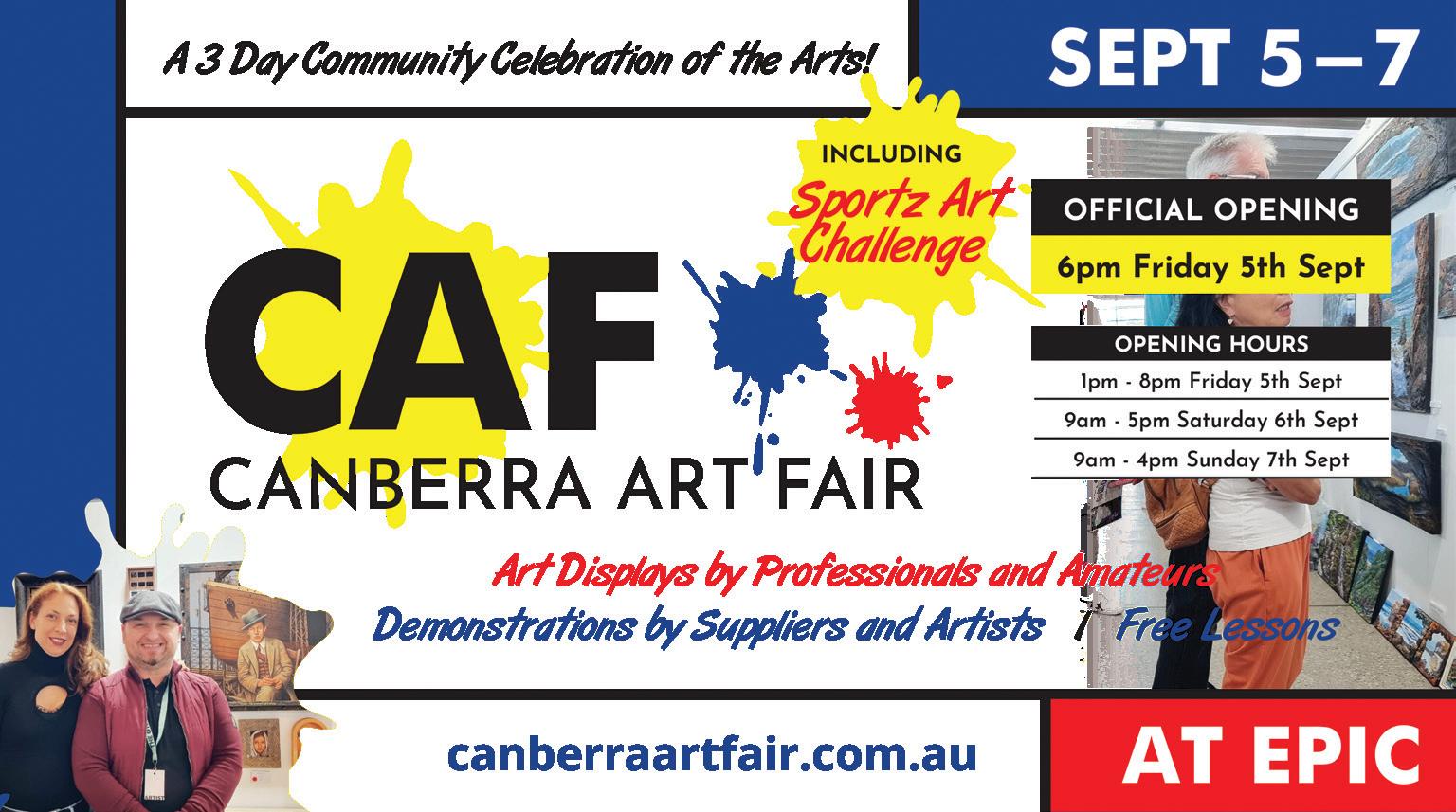
By Helen Musa
Visitors to the National Film and Sound Archive’s first art commission can expect to go on a weird descent through the circles of a modern-day hell before reaching their ultimate destination.
The consequence of an artist’s residence at the archive in January, Inferno is the brainchild of artist Mikaela Stafford, and owes some, but not all, of its inspiration to The Divine Comedy, by medieval Italian poet Dante Alighieri.
But there’ll be no wise Virgil to guide the protagonist through the circles, nor an angelic Beatrice to show the way to Paradise and Stafford, an illustrious Sydney College of the Arts and anyway, RMIT graduate, has been just as inspired by surprising finds in the lower depths of the archive.
I’m talking to her by WhatsApp to Paris, where she’s been living since June last year, close enough to her mum, who has retired to a village in the Bordeaux region.
“I’ve been trying to find a way to get to Europe for a while,” she says, “and Paris seems to hit all the various points in my life… it’s a walking city and I can also ride my bike.”
Because most of her work is digital, she says, she has the luxury of being able to move around, but Paris hits the spot as a centre of creativity.
She spent January in Canberra on a residency at the NFSA, “an amazing self-led
was taken into the physical storage vaults offsite in a large refrigerated room, but all the while she had senior curator at the gallery Tara Marynowsky guiding her, so it wasn’t a random search.
The idea gelled when she was shown Dark City, a 1998 neo-noir science fiction film directed by Aussie filmmaker Alex Proyas and largely shot at Fox Studios.
In it, Rufus Sewell plays an amnesiac man who wakes up in a hotel bathtub near the corpse of a murdered woman, then is warned to flee from a group of pale men in

trench coats “the Strangers”.

Marynowsky showed her costumes related to the film and Stafford went back twice, although she spent more blissful summer time sitting in the courtyard at the NFSA, sketching and making connections, also chatting freely with the production team about sculptural possibilities.
The idea of linking it up to Dante‘s Inferno only occurred to her back in Paris – “a hybrid idea, somewhat formed from Dark City that follows the trajectory of a character who wakes up in a bathtub, doesn’t know where they are, and then goes on an epic journey to figure it out, through shifting realities.”
Dante, too, goes on a relentless round of circles and experiences shifting realities, as
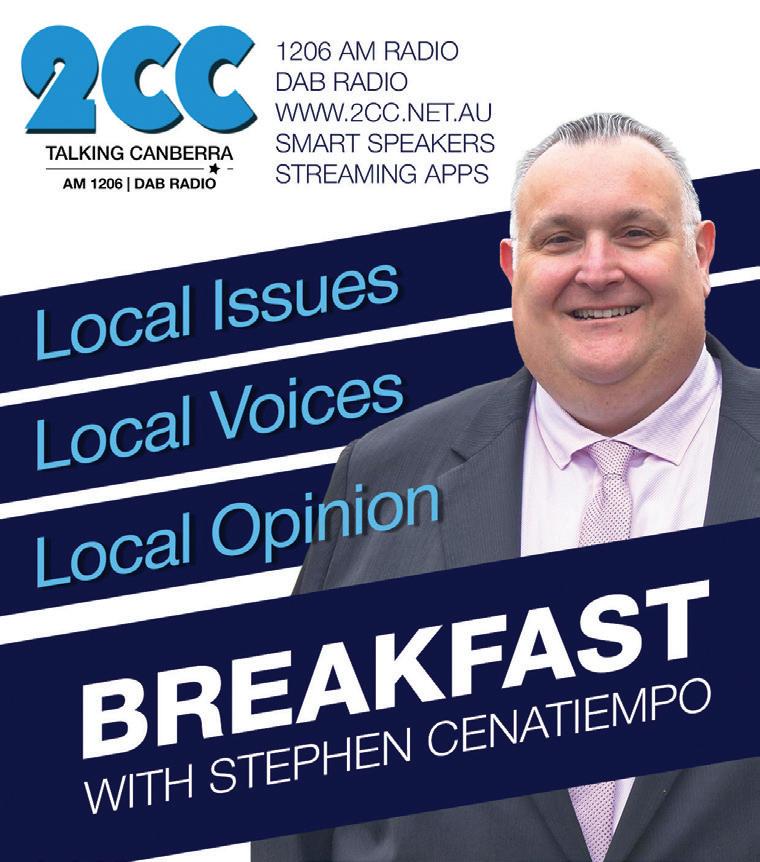

when he sees fortune-tellers and soothsayers walking with their heads on backwards.
So, what will we actually see?
First up, there will be a large, two-dimensional graphic sculpture that the NFSA calls “a large tome inscribed with other-worldly epic poetry scrawl”.
The central part is an unnerving 2.4mhigh liquid resin sculpture generated by an internal robotic so that the other-worldly form appears to ooze, “as if the sculpture has climbed out of the screen,” Stafford says.
Behind all of them is a massive 14m LED screen showing a seven-minute looped animation about a character who falls from grace, travels in an unknown world without any sense of direction, then ultimately finds
that the only way is forward.
“This is a journey into the unknown” Stafford says, “There is no dialogue, only music created by [Melbourne composer] Kate Durman, and it’s all in black-and-white.
“It’s an image of a world that I imagined and animated, but the character meets creatures on the way and that may be a bit deferential to Dante.”
Finally, her character descends to an abyss. And where does that lead? – into Purgatory –but that’s another story in a planned three-part series that had its genesis at the NFSA.
To be continued… in Paris, maybe. Inferno, the National Film and Sound Archive, until November 16. Free event.

In 1979 one of the most terrifying films ever made burst on to screens around the world.
Alien didn’t just subvert expectations but took a blowtorch to them.
Audiences were still riding a sci-fi high from Star Wars, which had been released two years earlier.
Many had gone to the movies expecting a similar adventure but instead were given an experience that has since been called “Jaws in space”.
Cinema folklore says that some people even fainted during the movie’s most frightening scenes.
Combine all of that with Sigourney Weaver’s iconic performance as Ellen Ripley and Alien became a surefire classic.
Since then, Ridley Scott’s creepy and claustrophobic masterpiece has been reimagined in a string of sequels and spinoffs trying to cash in on its popularity.

Some have been bad, some have been okay, but none have ever lived up to the haunting genius of the original.
However, a new show now streaming on Disney Plus may finally change the game.
Alien Earth is a new chapter in the sci-fi saga that brings the iconic xenomorph back.
Rather than exploring the frightening depths of space, this new series turns its gaze inward to our home planet, exploring a dystopian future controlled by mega corporations and a society being transformed by rapidly evolving artificial intelligence.
“We were safer in space”, its ominous
tagline tells us as a clever riff on the 1979 one that became a pop-culture staple, “In space no one can hear you scream”.
This new, more philosophical take on the Alien franchise comes from Noah Hawley, the creative lead behind the hit crime series Fargo.
That show was also inspired by an iconic older film, taking the fundamentals of its story and keeping it in a new way.
Fargo isn’t just a great television show, it’s one of the best out there, and if Hawley’s track record is anything to go by, Alien Earth

could be the most exciting thing to happen to the franchise since the original.
Best of all, Hawley has written the show to be approachable for those who haven’t seen the million-and-one sequels and spinoffs that have created unnecessary and tedious amounts of backstory.
He’s calling it “moral horror” and said he wants to tap into some of the more existential ideas that defined the first one.
Like Jaws, the original Alien worked best when it kept the monster hidden from audiences, letting their own imaginations
Lanyon Homestead will be turned into a living time machine for Turn Back Time, a one-day program of candle dipping, heirloom-conservation tips, cemetery ghost tales with Tim the Yowie Man and a courtyard bush dance with the Paverty Bush Band under the stars. Lanyon, Tharwa, August 30.
Luminescence Chamber Singers are the ACT recipi ents of the 2025 State and Territory Luminary Awards the big APRA AMCOS and the Australian Music Centre’s Art Music Awards.
Ignite Trio, a young ensemble from Canberra Girls Grammar School made up of Demi Katheklakis on marimba, Isabelle Hung on flute and Sanithi Herath on clarinet, are finalists in the Championship Section of Musica Viva Australia’s Strike A Chord competition. They will perform at the national final in Melbourne Recital Centre on August 30.
Actor, writer and musician Leo Amadeus has put to gether a collection of comedy songs and characters for the Sydney Fringe and will present them as a one-hour show under the title Horse Brother at the Courtyard Studio, Canberra Theatre Centre, on August 30. Among his original numbers are I Can’t Perform Classical Music and Patience is a Virtue (That I’ve Never Had).
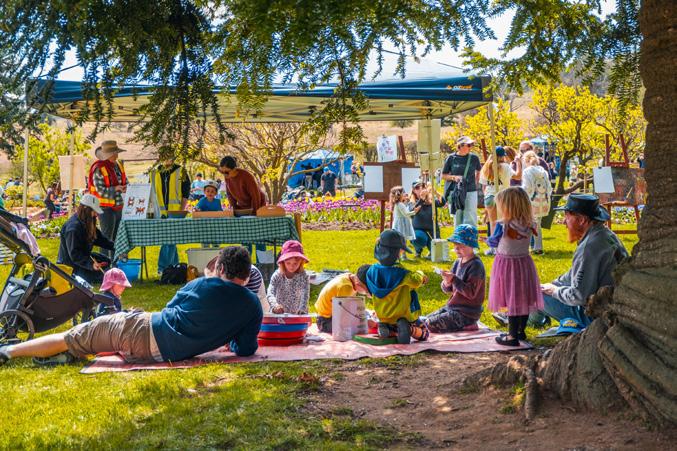
Turning Back Time at Lanyon on August 30.

A return season of The Q’s production of God of Carnage by French playwright Yasmina Reza, will be back in Queanbeyan before a tour of NSW, a feather in the cap of director Jordan Best. Queanbeyan Performing Arts Centre, August 29-31.
Local theatre and musical
identity Dianna Nixon will talk about her nine-year mission to reclaim the plays of Gunning farmer-playwright Millicent Armstrong, as part of Theatre Heritage Australia’s The Stage on Sunday. At Seaborn, Broughton & Walford Foundation, Young Street, Neutral Bay, Sydney, August 24.
Teatro, a 300-seat venue in the Italian Forum at Leichhardt, is a new professional theatre opening in the heart of Sydney’s inner west during spring, say artistic directors Nathan M Wright and Andrew Bevis.
do the work.
As a concept, the xenomorph shines brightest when it’s left in the dark and where darker than planet Earth for it to stalk its prey?
I’m sure those parental controls Disney Plus offers will be coming in handy for this one; it ain’t no Monsters Inc.
ALSO stirring up talk in the streaming world this month is Bookish, a new British detective series with a fun twist that is
Set in London post World War II, the show follows Gabriel Book, an idiosyncratic collector of antiquarian books that he sells in a cosy shop on Archangel Lane.
His fascination with these books turns into a powerful tool when police, and even Winston Churchill, call upon his help to solve
Sorting through the towers of knowledge he’s amassed over the years, Gabriel Book becomes an unlikely detective unearthing cases in the soot-stained streets of the Big
Bookish comes from Mark Gatiss, one of the co-creators of the hit series Sherlock, which reimagined Arthur Conan Doyle’s famous detective cracking cases in the modern day. The inspiration from Holmes is all over this one.
Gatiss also plays the central character and channels the many portrayals of Sherlock Holmes over the years into a new sleuth that he makes his own.
Bookish is a fun, easy watch with some intriguing new ideas that are far from elementary.

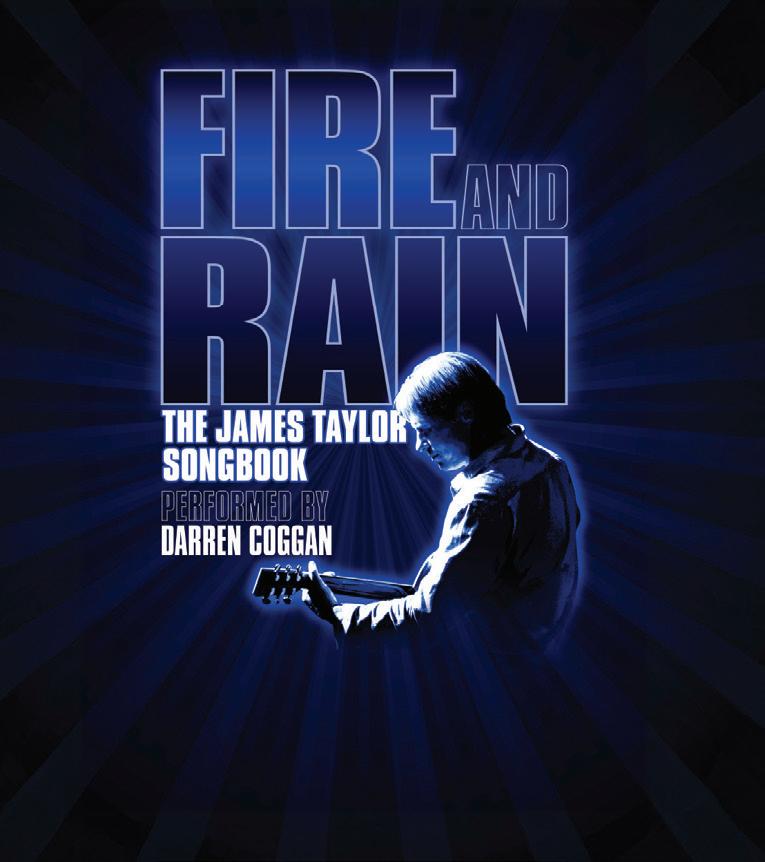


Tintino is small but mighty. A playful wine bar-bottle shop combo nestled on Kennedy Street, Kingston, Tintino invites customers to “take a seat or take it home”.





The menu is inviting and the food designed to pair with wines on offer.
Co-owners Ben Florance and Adam Brown know that in today’s crazy world of hospitality, being unique and lifting the bar are key. Brendan Hill, head chef, is in sync.
Sharing is the way to go at Tintino. Oysters are always a fabulous start to a meal, and we loved the plump, juicy ones sourced from Wheelers Oyster Farm (south coast) – a perfect temperature and served with a bright mignonette ($6.50 each, minimum of two).
Artisan bread sourced from L’épi Bakery, was soft and addicting ($6). We adored it with a wonderful, whipped parmesan and intensely flavoured, salty squid ink Bottarga ($12).
Perfectly poised Gildas feature a skewered juicy olive, punchy anchovy and pickled peppers ($7 each, minimum two). As an aside, some say this tapas-style snack is named after Rita Hayworth’s character in the 1946 film Gilda.
The truffle toasties were super fun and mighty tasty, much better than a Croque Monsieur, claimed one of our party ($16, we cut to share).
Quality ingredients are a full commitment at Tintino. An example is the rainbow trout sourced from the Snowy Mountains. It is high quality, firm and flaky but not overly fishy. Prepared with buttermilk and fennel, it was worth every bite ($35).
Gorgeous and inventive was the thick slices of pressed, succulent chicken leg, with goldenbrown skin and super sweet kernels of corn. The dish was elevated with saffron and truffle Madeira sauce ($38).

($15) and crispy brussel sprouts with local honey (hot) and Mimolette cheese ($15).
Everyone gave the thumbs up to the carrot dish. The purple and orange carrots were enhanced with caraway and topped with a chimichurri ($16).
Friends happened to be sitting close by, and they invited me over for a taste test of the chocolate terrine ($16) and sourdough toast ice
Customers can also explore and choose from the shelves of wine bottles on offer, with a mix of very approachable and very special options (currently $20 corkage fee for wines $45+). We selected a brilliant Domaine Jean Dauvissat Pere and Fils Chablis 2023 ($80).
I was back at the Hyatt for its Friday wine tasting, but the evening had started poorly.
The friend I’d expected to accompany me had the disaster of an elderly relative putting petrol in her diesel vehicle and trying to sort out next steps.
I thought of that old aphorism: “Some of us learn from the mistakes of others; the rest of us have to be the others.” Plus, I hate mistakes of all kinds, especially spelling mistakes: you mix up just two letters and your whole column is urined.
This particular week Lark Hill was the Hyatt’s featured winery. I started with a taste of the non-vintage Regional Blanc De Blanc, a sparkling chardonnay that is made in the traditional method.
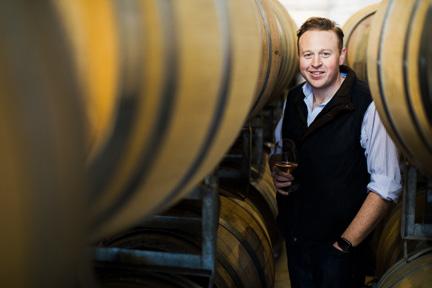

Chris Carpenter, the winemaker at Lark Hill, told me that the winery (located high above Bungendore) had been producing sparkling since 1993.
I had tasted the non-vintage Roxanne sparkling sangiovese, but not this one. It provided a bouquet of tropical fruit and was lively and mouth filling. There was no hint of brioche; it is a lighter style than many sparkling wines.

Next was the 2024 Regional Riesling. There
was more sweetness to this vintage than in the 2023 version of this wine, which was an award winner. Here, I tasted peach skins and a strong acid line that balanced out the sweetness well, the off-dry style of this wine palpable.
The last of the whites was a blend of Marsanne, Roussanne and Viognier, the 2024 Mr V. This is a style that derives from the Northern Rhone Valley in France where the blending of Marsanne and Roussanne is a classic.
Mr V could be cellared for quite some time: it is a textural wine with substantial complexity and minerality. I got a bouquet of grapefruit peel, with a slightly sour hit until the wine had received some air. After warming in my hand, I’d got a nutty finish to the wine and thought of
how it would match well with crustacea, such as grilled prawns.
The reds: first up was the Regional Pinot Noir 2024. Coincidentally, I’d had a glass of this wine the night before at Symposium wine bar at the ANU where I’d chosen it post gym because of its lightness and refreshing finish. The palate is hit with a lot of strawberry and this is an easy drinking pinot rather than earthy, forest-floor style of some pinots.
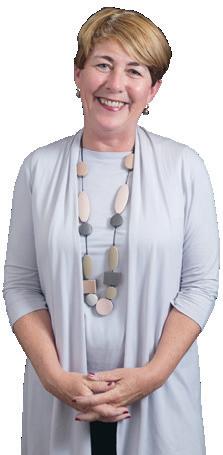
The Estate Sangiovese 2023 gave a bouquet of cherry with a hint of spice. The tannins are soft and it finished mildly, a food wine that would complement tomato-based dishes.
The Nero d’Avola 2023 was my favourite of the night with fruit from Gundagai and a great balance of that fruit with tannins. Medium bodied yet very juicy and mouth filling, this wine had red fruit flavours with a hint of white pepper. It deserves the two gold medals that Chris told me it had won.
The last wine of the tasting was the Teroldego 2023. Whereas Nero D’Avola is the dark-skinned grape of Southern Italy, particularly Sicily, this historic variety comes from Northern Italy where it is grown principally for its colour and is blended.
The fruit for this wine emanates from Victoria while Lark Hill awaits the maturity of its plantings. The wine was plush, easy to drink and the tannins were well rounded. This is a pleasant wine that I believe also would go well with food. Obviously, it was no mistake to go to this tasting. There was an incident a few years ago where I was sure I had made a mistake, but it turned out I was wrong.

By Joanne Madeline Moore
ARIES (Mar 21 – Apr 20)
This week hot-headed Rams are in a hurry! Fiery energy and enthusiasm are high, as you approach challenges with plenty of confidence and courage. But being bossy and promising more than you can deliver (especially with family and friends) is a danger. Don’t over-estimate your abilities – or underestimate the amount of time you have available. Slow down! Do your best to combine spontaneity with responsibility, and passion with persistence.
TAURUS (Apr 21 – May 21)
Courtesy of your power planet Venus, it’s a good week to step in and take the initiative with a family member who is facing challenges. If you offer a calm, considered solution (without being bossy or judgmental) then they might just accept your advice! When it comes to a paid job or a volunteer position, a practical step-by-step plan could lead to more productivity in the future. But avoid being an unreasonably stubborn Bull at work, especially on Wednesday.
GEMINI (May 22 – June 21)
Expect a busy, bustling week when the planets stir up your curious mind and restless heart, and you want to soar and explore like an eagle. Energy and enthusiasm are high but don’t say or do something unintentionally hurtful. Hasty words can upset others, so think before you speak and self-edit along the way. Be inspired by birthday great, singer-songwriter Florence Welch (who has the Sun in Virgo and Moon in Gemini): “I like the idea of taking off like a bird.”
CANCER (June 22 – July 23)
When it comes to work, career, creativity and/or financial matters, things could be very frustrating this week. So, heed the wise words of billionaire Warren Buffett (who was born on August 30, 1930): “I’ve had periods of my life when I’ve had a bundle of ideas come along, and I’ve had long dry spells.” Be patient, keep things in perspective and keep plugging away as you put your clever Crab mind to good use via reading, writing and researching.
LEO (July 24 – Aug 23)
Don’t be deceived by glossy, glamorous appearances! You can be dazzled by outer beauty but this week you need to look beneath the surface to evaluate a person’s true worth. You’re also keen to escape the harsh realities of daily life as you read a fantasy novel, listen to uplifting music, watch a romantic movie or daydream the hours away. Just make sure you can differentiate between fact and fiction. Avoid getting drawn into a power struggle on Wednesday.
VIRGO (Aug 24 – Sept 23)
Being kind of heart and doing good deeds are highlighted, as Mercury and Venus stimulate your humanitarian streak. So, it’s a suitable week to express your Good Samaritan side. Perhaps you can nurse a sick family member, support a friend in need, do some volunteer work or lend a helping hand in your local community? But thrifty Saturn cautions you about financial matters. With the cost of living soaring, there may not be as much in the kitty as you think!
LIBRA (Sept 24 – Oct 23)
It’s a good time to connect, network, negotiate and socialise with like-minded souls within your sphere of influence. It’s not what you know but who you know! You could also be approached to contribute your talents to a group dynamic like a class or club. But the Mercury/Pluto opposition stirs up your creativity and friendship zones, so projects and people will be hard to pin down. You’ll find the more patient and flexible you are, the better the week will be.
SCORPIO (Oct 24 – Nov 22)
You’re keen to call the shots but remember there’s a big difference between leading others and being plain bossy. This week domineering behaviour and control-freak tendencies will just lead to unnecessary dramas. So, slip on your humility hat and be more consultative and cooperative, especially at work and home. With Saturn activating your health-and-wellbeing zone, find time in your busy life to prepare nutritious meals and follow a regular fitness routine.
SAGITTARIUS (Nov 23 – Dec 21)
This week’s stars encourage nurturing a long-term relationship or starting a new romance that has the potential to last the distance. Don’t be afraid of making messy mistakes… and learning from them. As music diva (and birthday great) Florence Welch observes: “If you do something with your whole heart and it’s a mistake, you can live with that.” But if you communicate with too much fiery intensity (especially on Wednesday) then it could scare others away.
CAPRICORN (Dec 22 – Jan 20)
The Sun (in fellow earth sign Virgo) boosts productivity and activates your aspirational side, so it’s a good week to dream big dreams and take plenty of positive action. Even in tough times – nothing ventured; nothing gained! Be inspired by Swedish movie star Ingrid Bergman (who was born on August 29, 1917): “I don’t regret a thing I’ve done. I only regret the things I didn’t do.” But resist the temptation to over-promise and underdeliver, especially at work.
AQUARIUS (Jan 21 – Feb 19)
Avoid being a lone wolf this week, Aquarius. If you nurture partnerships, then you can combine your talents on a creative joint project. You’ll have to be patient, though, as you work towards achieving a long-term goal. But a relationship with a work colleague or family member could cool suddenly, as responsibilities overtake having fun. Don’t stress and worry. If you keep the lines of communication open, then the storm in a teacup will soon blow over.
PISCES (Feb 20 – Mar 20)
It’s a good week to dream, imagine, create and innovate, as Venus and Uranus form wonderful aspects with inspirational Neptune (your patron planet). So, it’s time for Fish to fly into the great imaginative and mystical unknown! Be inspired by singer-songwriter Florence Welch (who turns 39 on Thursday): “I try to maintain a healthy dose of daydreaming, to remain sane.” But resist the urge to slip into negative thoughts and sabotaging self-talk on Wednesday.
Copyright Joanne Madeline Moore 2025



•
•
•



Your journey to better health starts here.
At Winnunga Nimmityjah Aboriginal Health and Community Services, we stand with you on your journey to quit smoking — for yourself, for your family, and for future generations. Smoking is one of the biggest health challenges in our community, but you are stronger than the smokes. Every cigarette not smoked is a step toward a longer, healthier life.
Winnunga offers culturally safe, free, and confidential support:
• Quit plans tailored for you
Why Quit?
Stronger lungs, stronger heart, stronger you
More money in your pocket — save thousands every year
Healthy bubbas — quitting before or during pregnancy helps babies grow strong
Be a role model for your kids, your mob, your community
It’s Never Too Late
Whether it’s your first time trying or your fifth, Winnunga is here to walk with you. Every day smoke-free is a win.

• Yarn with our friendly Aboriginal Health Workers
• Free nicotine replacement therapy (patches, gum, sprays)
• Ongoing support and encouragement at every step
